

5 Easy Steps to Solve Any Word Problem in Math
- February 27, 2021
Picture this my teacher besties. You are solving word problems in your math class and every student, yes every student knows how to solve word problems without immediately entering a state of confusion! They know how to attack the problem head-on and have a method to solve every single problem that is presented to them.
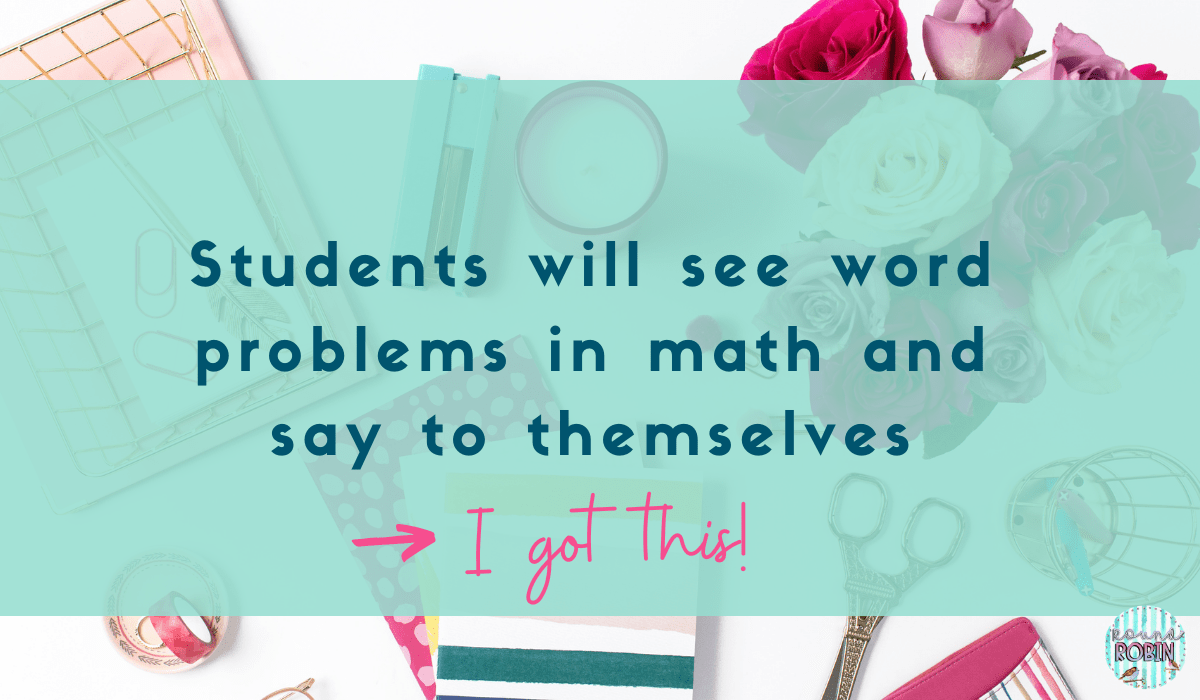
How Do You Solve Word Problems in Math?
Ask yourself this, what do you think is the #1 phrase a student says as soon as they see a word problem?
You guessed it, my teacher friend, I don’t know how to do this! I think the most common question I get when I’m teaching my math classes, is how do I solve this?
Students see word problems and immediately enter freak-out mode! Let’s take solving word problems in the classroom and make it easier for students to SOLVE the problem!
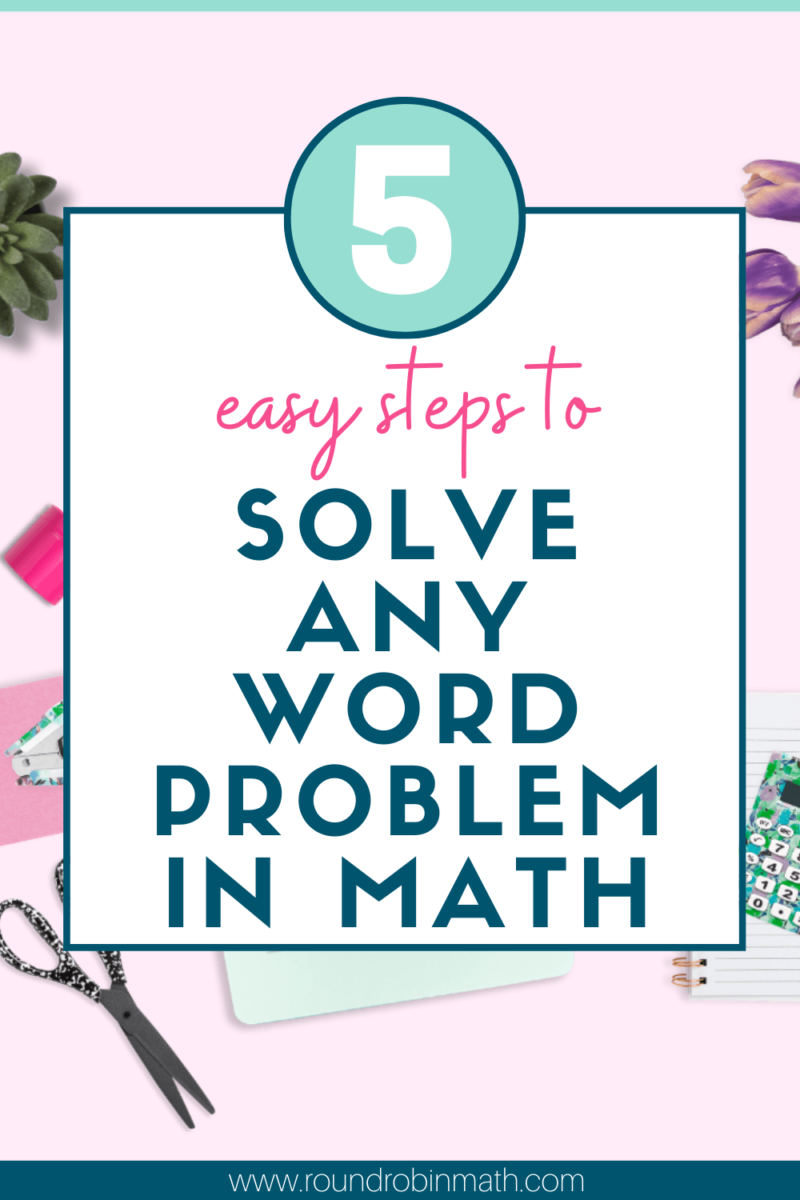
How to Solve Word Problems Step by Step
There are so many methods that students can choose from when learning how to solve word problems. The 4 step method is the foundation for all of the methods that you will see, but what about a variation of the 4 step method that every student can do just because they get it.
Students are most likely confused about how to solve word problems because they have never used a consistent method over the years. I’m all about consistency in my classroom. Fortunately, in my school district, I get to teach most of the students year after year because of how small our class sizes are. So I’m going to give you a method based on the 4 step method, that allows all students to be successful at solving word problems.
Even the most unmotivated math student will learn how to solve word problems and not skip them!
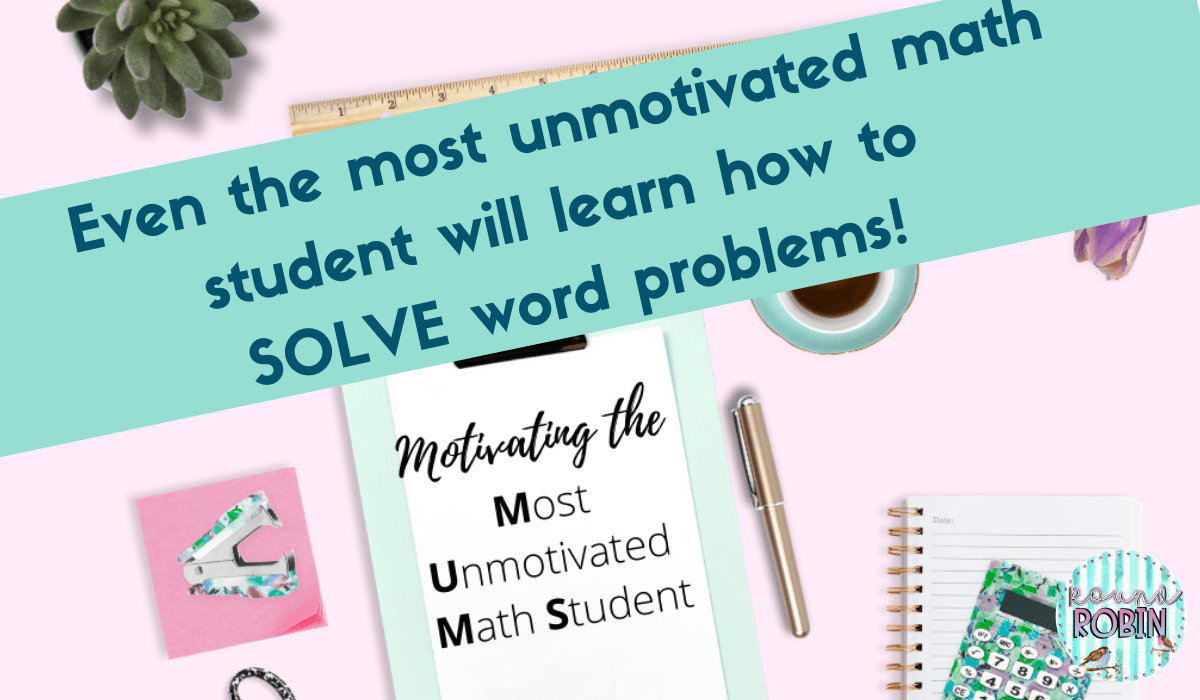
Tips, Tricks, and Teaching Strategies to Solving Word Problems in Math
Going back to the 4 step method just in case you need a refresher. If you know me at all a little reminder of “oh yeah I remember that now” always helps me!
4 steps in solving word problems in math:
- Understand the Problem
- Plan the solution
- Solve the Problem
- Check the solution
This 4 step method is the basis of the method I’m going to tell you all about. The problem isn’t with the method itself, it is the fact that most students see word problems and just start panicking!
Why can they do an entire assignment and then see a word problem and then suddenly stop? Is there a reason why books are designed with word problems at the end?
These are questions that I constantly have asked myself over the last several years. I finally got to the point where my students needed a consistent approach to solving word problems that worked every single time.
The first thing I knew I needed to start doing was introducing students to word problems at the beginning of each lesson.
Once students first see the word problems at the beginning of the lesson, they are less likely to be scared of them when it comes time to do it by themselves!
This also will increase their confidence in the classroom. In case you missed it, I shared all about how I increase my students’ confidence in the classroom.
Wonder how increasing their confidence will help keep them motivated in the classroom?
So confident motivated students will see word problems that could be on their homework, any standardized test, and say I GOT THIS!
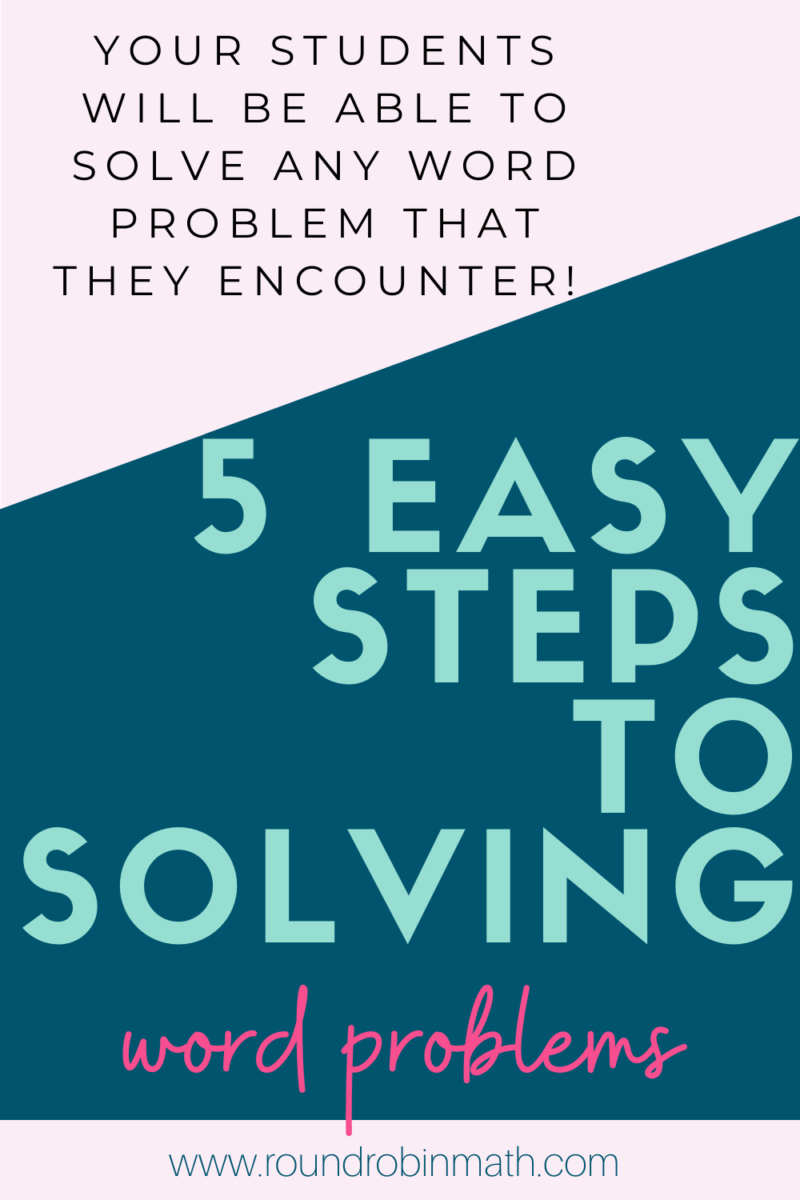
Steps to Solving Word Problems in Mathematics
We are ready to SOLVE any word problem our students are going to encounter in math class.
Here are my 5 easy steps to SOLVE any word problem in math:
- S – State the objective
- O – Outline your plan
- L – Look for Key Details – Information
- V – Verify and Solve
- E – Explain and check your solution
Do you want to learn how to implement this 5 steps problem-solving strategy into your classroom? I’m hosting a FREE workshop all about how to implement this strategy in your classroom!

I am so excited to be offering a workshop to increase students’ confidence in solving word problems. The workshop is held in my Facebook Group The Round Robin Math Community. It also will be sent straight to your inbox and you can watch it right now!
If you’re interested, join today and all the details will be sent to you ASAP!
I will see you there!
PS. Need the SOLVE method for your bulletin board for your students’ math journals/notebooks? Check out this bulletin board resource here:
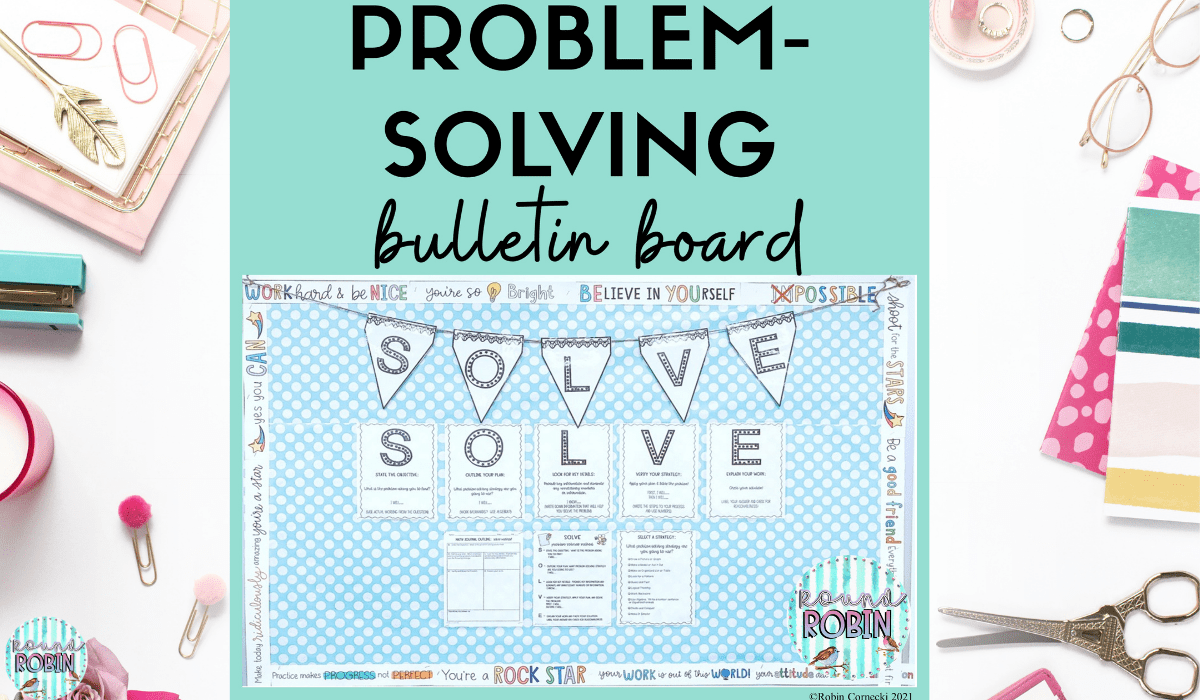
Love, Robin
- Latest Posts

Robin Cornecki
Latest posts by robin cornecki ( see all ).
- The #1 method for finding slope without using a formula! - April 25, 2023
- Here’s a Quick Way to Convert Percents to Fractions and Decimals. - July 21, 2022
- How to use the Four-Function Calculator for the Praxis Core Math Test. - April 23, 2022

Hi, I'm Robin!
I am a secondary math teacher with over 19 years of experience! If you’re a teacher looking for help with all the tips, tricks, and strategies for passing the praxis math core test, you’re in the right place!
I also create engaging secondary math resources for grades 7-12!
Learn more about me and how I can help you here .
Let's Connect!
Get my top 7 strategies.

- Math for Kids
- Parenting Resources
- ELA for Kids
- Teaching Resources

How to Teach Number Formation in 5 Easy Steps
13 Best Resources for Math Videos for Kids: Math Made Fun
How to Teach Skip Counting to Kids in 9 Easy Steps
10 Best Math Intervention Strategies for Struggling Students
How to Teach Division to Kids in 11 Easy Steps
How to Cope With Test Anxiety in 12 Easy Ways
Developmental Milestones for 4 Year Olds: The Ultimate Guide
Simple & Stress-Free After School Schedule for Kids of All Ages
When Do Kids Start Preschool: Age & Readiness Skills
Kindergarten Readiness Checklist: A Guide for Parents
How to Teach Letter Formation to Kids in 9 Easy Steps
15 Best Literacy Activities for Preschoolers in 2024
12 Best Poems About Teachers Who Change Lives
6 Effective Ways to Improve Writing Skills
40 Four Letter Words That Start With A
60 Fun Animal Facts for Kids
12 Best Behavior Management Techniques for the Classroom
13 Best Online Teaching Tips for Teachers
How to Teach Kids to Write in 9 Easy Steps
13 Challenges for Teachers and How to Address Them

10 Best Strategies for Solving Math Word Problems
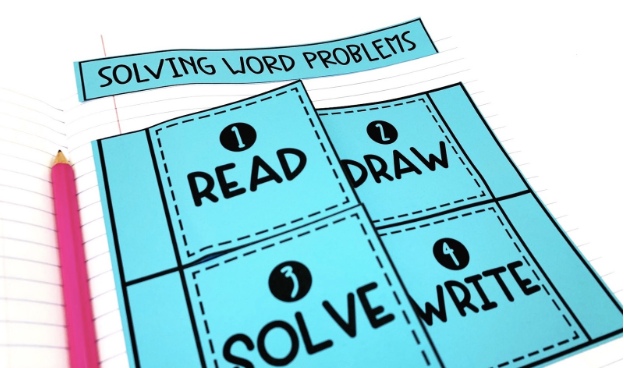
1. Understand the Problem by Paraphrasing
2. identify key information and variables, 3. translate words into mathematical symbols, 4. break down the problem into manageable parts, 5. draw diagrams or visual representations, 6. use estimation to predict answers, 7. apply logical reasoning for unknown variables, 8. leverage similar problems as templates, 9. check answers in the context of the problem, 10. reflect and learn from mistakes.
Have you ever observed the look of confusion on a student’s face when they encounter a math word problem ? It’s a common sight in classrooms worldwide, underscoring the need for effective strategies for solving math word problems . The main hurdle in solving math word problems is not just the math itself but understanding how to translate the words into mathematical equations that can be solved.
SplashLearn: Most Comprehensive Learning Program for PreK-5

SplashLearn inspires lifelong curiosity with its game-based PreK-5 learning program loved by over 40 million children. With over 4,000 fun games and activities, it’s the perfect balance of learning and play for your little one.
Generic advice like “read the problem carefully” or “practice more” often falls short in addressing students’ specific difficulties with word problems. Students need targeted math word problem strategies that address the root of their struggles head-on.
A Guide on Steps to Solving Word Problems: 10 Strategies
One of the first steps in tackling a math word problem is to make sure your students understand what the problem is asking. Encourage them to paraphrase the problem in their own words. This means they rewrite the problem using simpler language or break it down into more digestible parts. Paraphrasing helps students grasp the concept and focus on the problem’s core elements without getting lost in the complex wording.
Original Problem: “If a farmer has 15 apples and gives away 8, how many does he have left?”
Paraphrased: “A farmer had some apples. He gave some away. Now, how many apples does he have?”
This paraphrasing helps students identify the main action (giving away apples) and what they need to find out (how many apples are left).
Play these subtraction word problem games in the classroom for free:

Students often get overwhelmed by the details in word problems. Teach them to identify key information and variables essential for solving the problem. This includes numbers , operations ( addition , subtraction , multiplication , division ), and what the question is asking them to find. Highlighting or underlining can be very effective here. This visual differentiation can help students focus on what’s important, ignoring irrelevant details.
- Encourage students to underline numbers and circle keywords that indicate operations (like ‘total’ for addition and ‘left’ for subtraction).
- Teach them to write down what they’re solving for, such as “Find: Total apples left.”
Problem: “A classroom has 24 students. If 6 more students joined the class, how many students are there in total?”
Key Information:
- Original number of students (24)
- Students joined (6)
- Looking for the total number of students
Here are some fun addition word problems that your students can play for free:

The transition from the language of word problems to the language of mathematics is a critical skill. Teach your students to convert words into mathematical symbols and equations. This step is about recognizing keywords and phrases corresponding to mathematical operations and expressions .
Common Translations:
- “Total,” “sum,” “combined” → Addition (+)
- “Difference,” “less than,” “remain” → Subtraction (−)
- “Times,” “product of” → Multiplication (×)
- “Divided by,” “quotient of” → Division (÷)
- “Equals” → Equals sign (=)
Problem: “If one book costs $5, how much would 4 books cost?”
Translation: The word “costs” indicates a multiplication operation because we find the total cost of multiple items. Therefore, the equation is 4 × 5 = $20
Complex math word problems can often overwhelm students. Incorporating math strategies for problem solving, such as teaching them to break down the problem into smaller, more manageable parts, is a powerful approach to overcome this challenge. This means looking at the problem step by step rather than simultaneously trying to solve it. Breaking it down helps students focus on one aspect of the problem at a time, making finding the solution more straightforward.
Problem: “John has twice as many apples as Sarah. If Sarah has 5 apples, how many apples do they have together?”
Steps to Break Down the Problem:
Find out how many apples John has: Since John has twice as many apples as Sarah, and Sarah has 5, John has 5 × 2 = 10
Calculate the total number of apples: Add Sarah’s apples to John’s to find the total, 5 + 10 = 15
By splitting the problem into two parts, students can solve it without getting confused by all the details at once.
Explore these fun multiplication word problem games:

Diagrams and visual representations can be incredibly helpful for students, especially when dealing with spatial or quantity relationships in word problems. Encourage students to draw simple sketches or diagrams to represent the problem visually. This can include drawing bars for comparison, shapes for geometry problems, or even a simple distribution to better understand division or multiplication problems .
Problem: “A garden is 3 times as long as it is wide. If the width is 4 meters, how long is the garden?”
Visual Representation: Draw a rectangle and label the width as 4 meters. Then, sketch the length to represent it as three times the width visually, helping students see that the length is 4 × 3 = 12
Estimation is a valuable skill in solving math word problems, as it allows students to predict the answer’s ballpark figure before solving it precisely. Teaching students to use estimation can help them check their answers for reasonableness and avoid common mistakes.
Problem: “If a book costs $4.95 and you buy 3 books, approximately how much will you spend?”
Estimation Strategy: Round $4.95 to the nearest dollar ($5) and multiply by the number of books (3), so 5 × 3 = 15. Hence, the estimated total cost is about $15.
Estimation helps students understand whether their final answer is plausible, providing a quick way to check their work against a rough calculation.
Check out these fun estimation and prediction word problem worksheets that can be of great help:

When students encounter problems with unknown variables, it’s crucial to introduce them to logical reasoning. This strategy involves using the information in the problem to deduce the value of unknown variables logically. One of the most effective strategies for solving math word problems is working backward from the desired outcome. This means starting with the result and thinking about the steps leading to that result, which can be particularly useful in algebraic problems.
Problem: “A number added to three times itself equals 32. What is the number?”
Working Backward:
Let the unknown number be x.
The equation based on the problem is x + 3x = 32
Solve for x by simplifying the equation to 4x=32, then dividing by 4 to find x=8.
By working backward, students can more easily connect the dots between the unknown variable and the information provided.
Practicing problems of similar structure can help students recognize patterns and apply known strategies to new situations. Encourage them to leverage similar problems as templates, analyzing how a solved problem’s strategy can apply to a new one. Creating a personal “problem bank”—a collection of solved problems—can be a valuable reference tool, helping students see the commonalities between different problems and reinforcing the strategies that work.
Suppose students have solved a problem about dividing a set of items among a group of people. In that case, they can use that strategy when encountering a similar problem, even if it’s about dividing money or sharing work equally.
It’s essential for students to learn the habit of checking their answers within the context of the problem to ensure their solutions make sense. This step involves going back to the original problem statement after solving it to verify that the answer fits logically with the given information. Providing a checklist for this process can help students systematically review their answers.
Checklist for Reviewing Answers:
- Re-read the problem: Ensure the question was understood correctly.
- Compare with the original problem: Does the answer make sense given the scenario?
- Use estimation: Does the precise answer align with an earlier estimation?
- Substitute back: If applicable, plug the answer into the problem to see if it works.
Problem: “If you divide 24 apples among 4 children, how many apples does each child get?”
After solving, students should check that they understood the problem (dividing apples equally).
Their answer (6 apples per child) fits logically with the number of apples and children.
Their estimation aligns with the actual calculation.
Substituting back 4×6=24 confirms the answer is correct.
Teaching students to apply logical reasoning, leverage solved problems as templates, and check their answers in context equips them with a robust toolkit for tackling math word problems efficiently and effectively.
One of the most effective ways for students to improve their problem-solving skills is by reflecting on their errors, especially with math word problems. Using word problem worksheets is one of the most effective strategies for solving word problems, and practicing word problems as it fosters a more thoughtful and reflective approach to problem-solving
These worksheets can provide a variety of problems that challenge students in different ways, allowing them to encounter and work through common pitfalls in a controlled setting. After completing a worksheet, students can review their answers, identify any mistakes, and then reflect on them in their mistake journal. This practice reinforces mathematical concepts and improves their math problem solving strategies over time.
3 Additional Tips for Enhancing Word Problem-Solving Skills
Before we dive into the importance of reflecting on mistakes, here are a few impactful tips to enhance students’ word problem-solving skills further:
1. Utilize Online Word Problem Games
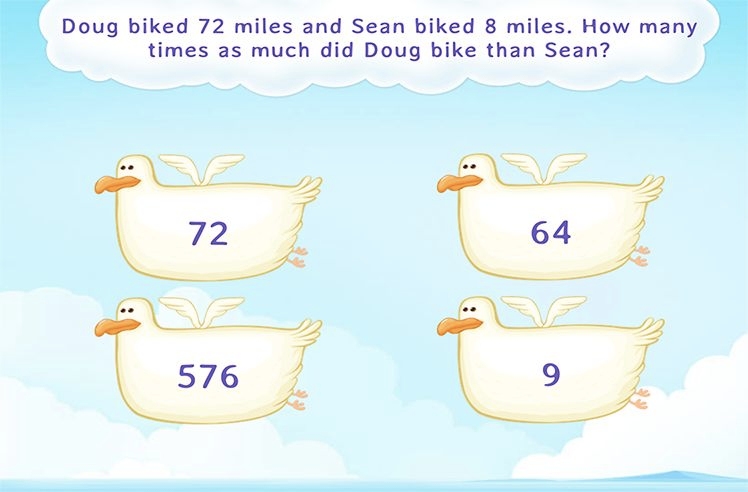
Incorporate online games that focus on math word problems into your teaching. These interactive platforms make learning fun and engaging, allowing students to practice in a dynamic environment. Games can offer instant feedback and adaptive challenges, catering to individual learning speeds and styles.
Here are some word problem games that you can use for free:

2. Practice Regularly with Diverse Problems
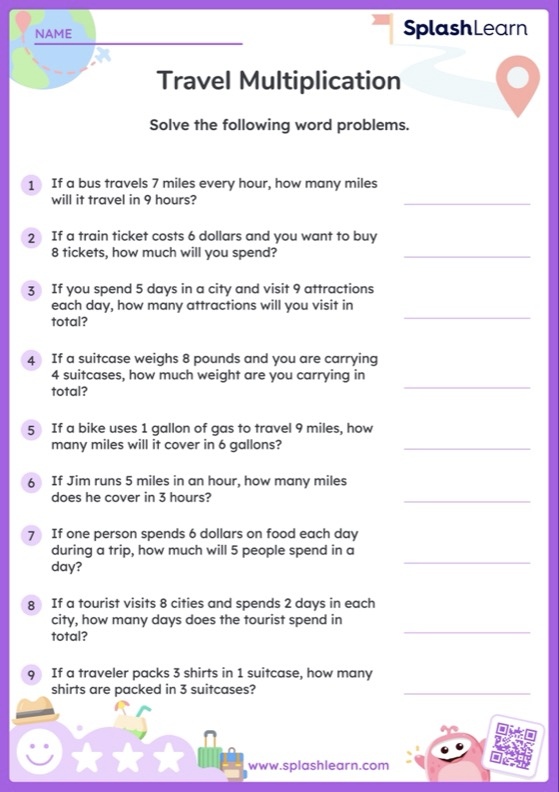
Consistent practice with a wide range of word problems helps students become familiar with different questions and mathematical concepts. This exposure is crucial for building confidence and proficiency.
Start Practicing Word Problems with these Printable Word Problem Worksheets:

3. Encourage Group Work
Solving word problems in groups allows students to share strategies and learn from each other. A collaborative approach is one of the best strategies for solving math word problems that can unveil multiple methods for tackling the same problem, enriching students’ problem-solving toolkit.
Conclusion
Mastering math word problems is a journey of small steps. Encourage your students to practice regularly, stay curious, and learn from their mistakes. These strategies for solving math word problems are stepping stones to turning challenges into achievements. Keep it simple, and watch your students grow their confidence and skills, one problem at a time.
Frequently Asked Questions (FAQs)
How can i help my students stay motivated when solving math word problems.
Encourage small victories and use engaging tools like online games to make practice fun and rewarding.
What's the best way to teach beginners word problems?
Begin with simple problems that integrate everyday scenarios to make the connection between math and real-life clear and relatable.
How often should students practice math word problems?
Regular, daily practice with various problems helps build confidence and problem-solving skills over time.
- Pre-Kindergarten
- Kindergarten
Most Popular

15 Best Report Card Comments Samples

117 Best Riddles for Kids (With Answers)
40 best good vibes quotes to brighten your day, recent posts.
![What is World Homeschooling & how To Start [Full Guide] kids walking around the world](https://www.splashlearn.com/blog/wp-content/uploads/2024/05/what-is-world-homeschooling-100x70.jpg)
What is World Homeschooling & how To Start [Full Guide]

15 Best Movement Activities for Preschoolers in 2024

10 Best Online Homeschool Programs
Math & ela | prek to grade 5, kids see fun., you see real learning outcomes..
Watch your kids fall in love with math & reading through our scientifically designed curriculum.
Parents, try for free Teachers, use for free

- Games for Kids
- Worksheets for Kids
- Math Worksheets
- ELA Worksheets
- Math Vocabulary
- Number Games
- Addition Games
- Subtraction Games
- Multiplication Games
- Division Games
- Addition Worksheets
- Subtraction Worksheets
- Multiplication Worksheets
- Division Worksheets
- Times Tables Worksheets
- Reading Games
- Writing Games
- Phonics Games
- Sight Words Games
- Letter Tracing Games
- Reading Worksheets
- Writing Worksheets
- Phonics Worksheets
- Sight Words Worksheets
- Letter Tracing Worksheets
- Prime Number
- Order of Operations
- Long multiplication
- Place value
- Parallelogram
- SplashLearn Success Stories
- SplashLearn Apps
- [email protected]
© Copyright - SplashLearn

Make study-time fun with 14,000+ games & activities, 450+ lesson plans, and more—free forever.
Parents, Try for Free Teachers, Use for Free

How do you solve word problems in math?
Master word problems with eight simple steps from a math tutor!

Author Amber Watkins
Published April 2024

- Key takeaways
- Students who struggle with reading, tend to struggle with understanding and solving word problems. So the best way to solve word problems in math is to become a better reader!
- Mastery of word problems relies on your child’s knowledge of keywords for word problems in math and knowing what to do with them.
- There are 8 simple steps each child can use to solve word problems- let’s go over these together.
Table of contents
- How to solve word problems
Lesson credits
As a tutor who has seen countless math worksheets in almost every grade – I’ll tell you this: every child is going to encounter word problems in math. The key to mastery lies in how you solve them! So then, how do you solve word problems in math?
In this guide, I’ll share eight steps to solving word problems in math.
How to solve word problems in math in 8 steps
Step 1: read the word problem aloud.
For a child to understand a word problem, it needs to be read with accuracy and fluency! That is why, when I tutor children with word problems, I always emphasize the importance of reading properly.
Mastering step 1 looks like this:
- Allow your child to read the word problem aloud to you.
- Don’t let your child skip over or mispronounce any words.
- If necessary, model how to read the word problem, then allow your child to read it again. Only after the word problem is read accurately, should you move on to step 2.
Step 2: Highlight the keywords in the word problem
The keywords for word problems in math indicate what math action should be taken. Teach your child to highlight or underline the keywords in every word problem.
Here are some of the most common keywords in math word problems:
- Subtraction words – less than, minus, take away
- Addition words – more than, altogether, plus, perimeter
- Multiplication words – Each, per person, per item, times, area
- Division words – divided by, into
- Total words – in all, total, altogether
Let’s practice. Read the following word problem with your child and help them highlight or underline the main keyword, then decide which math action should be taken.
Michael has ten baseball cards. James has four baseball cards less than Michael. How many total baseball cards does James have?
The words “less than” are the keywords and they tell us to use subtraction .
Step 3: Make math symbols above keywords to decode the word problem
As I help students with word problems, I write math symbols and numbers above the keywords. This helps them to understand what the word problem is asking.
Let’s practice. Observe what I write over the keywords in the following word problem and think about how you would create a math sentence using them:

Step 4: Create a math sentence to represent the word problem
Using the previous example, let’s write a math sentence. Looking at the math symbols and numbers written above the word problem, our math sentence should be: 10 – 5 = 5 !
Each time you practice a word problem with your child, highlight keywords and write the math symbols above them. Then have your child create a math sentence to solve.
Step 5: Draw a picture to help illustrate the word problem
Pictures can be very helpful for problems that are more difficult to understand. They also are extremely helpful when the word problem involves calculating time , comparing fractions , or measurements .
Step 6: Always show your work
Help your child get into the habit of always showing their work. As a tutor, I’ve found many reasons why having students show their work is helpful:
- By showing their work, they are writing the math steps repeatedly, which aids in memory
- If they make any mistakes they can track where they happened
- Their teacher can assess how much they understand by reviewing their work
- They can participate in class discussions about their work
Step 7: When solving word problems, make sure there is always a word in your answer!
If the word problem asks: How many peaches did Lisa buy? Your child’s answer should be: Lisa bought 10 peaches .
If the word problem asks: How far did Kyle run? Your child’s answer should be: Kyle ran 20 miles .
So how do you solve a word problem in math?
Together we reviewed the eight simple steps to solve word problems. These steps included identifying keywords for word problems in math, drawing pictures, and learning to explain our answers.
Is your child ready to put these new skills to the test? Check out the best math app for some fun math word problem practice.

Parents, sign up for a DoodleMath subscription and see your child become a math wizard!

Amber Watkins
Amber is an education specialist with a degree in Early Childhood Education. She has over 12 years of experience teaching and tutoring elementary through college level math. "Knowing that my work in math education makes such an impact leaves me with an indescribable feeling of pride and joy!"
What we offer
Quick links
All rights reserved.

Are you a parent, teacher or student?
Get started for free!
Maths information pack
We ask for your contact info so we can send our info pack directly to your inbox for your convenience, exam prep information pack, case studies information pack.
Book a chat with our team

I’m new to Doodle

My school is already using Doodle

Information pack
We ask for your contact info so that our education consultants can get in touch with you and let you know a bit more about doodle., student login, which programme would you like to use.
DoodleMaths
DoodleTables
DoodleEnglish
DoodleSpell
If you’d like to use Doodle’s browser version, please visit this page on a desktop.
To log in to Doodle on this device, you can do so through our apps. You can find out how to download them here:

- Get started with computers
- Learn Microsoft Office
- Apply for a job
- Improve my work skills
- Design nice-looking docs
- Getting Started
- Smartphones & Tablets
- Typing Tutorial
- Online Learning
- Basic Internet Skills
- Online Safety
- Social Media
- Zoom Basics
- Google Docs
- Google Sheets
- Career Planning
- Resume Writing
- Cover Letters
- Job Search and Networking
- Business Communication
- Entrepreneurship 101
- Careers without College
- Job Hunt for Today
- 3D Printing
- Freelancing 101
- Personal Finance
- Sharing Economy
- Decision-Making
- Graphic Design
- Photography
- Image Editing
- Learning WordPress
- Language Learning
- Critical Thinking
- For Educators
- Translations
- Staff Picks
- English expand_more expand_less
Algebra Topics - Introduction to Word Problems
Algebra topics -, introduction to word problems, algebra topics introduction to word problems.

Algebra Topics: Introduction to Word Problems
Lesson 9: introduction to word problems.
/en/algebra-topics/solving-equations/content/
What are word problems?
A word problem is a math problem written out as a short story or scenario. Basically, it describes a realistic problem and asks you to imagine how you would solve it using math. If you've ever taken a math class, you've probably solved a word problem. For instance, does this sound familiar?
Johnny has 12 apples. If he gives four to Susie, how many will he have left?
You could solve this problem by looking at the numbers and figuring out what the problem is asking you to do. In this case, you're supposed to find out how many apples Johnny has left at the end of the problem. By reading the problem, you know Johnny starts out with 12 apples. By the end, he has 4 less because he gave them away. You could write this as:
12 - 4 = 8 , so you know Johnny has 8 apples left.
Word problems in algebra
If you were able to solve this problem, you should also be able to solve algebra word problems. Yes, they involve more complicated math, but they use the same basic problem-solving skills as simpler word problems.
You can tackle any word problem by following these five steps:
- Read through the problem carefully, and figure out what it's about.
- Represent unknown numbers with variables.
- Translate the rest of the problem into a mathematical expression.
- Solve the problem.
- Check your work.
We'll work through an algebra word problem using these steps. Here's a typical problem:
The rate to rent a small moving van is $30 per day, plus $0.50 per mile. Jada rented a van to drive to her new home. It took two days, and the van cost $360. How many miles did she drive?
It might seem complicated at first glance, but we already have all of the information we need to solve it. Let's go through it step by step.
Step 1: Read through the problem carefully.
With any problem, start by reading through the problem. As you're reading, consider:
- What question is the problem asking?
- What information do you already have?
Let's take a look at our problem again. What question is the problem asking? In other words, what are you trying to find out?
The rate to rent a small moving van is $30 per day, plus $0.50 per mile. Jada rented a van to drive to her new home. It took 2 days, and the van cost $360. How many miles did she drive?
There's only one question here. We're trying to find out how many miles Jada drove . Now we need to locate any information that will help us answer this question.
There are a few important things we know that will help us figure out the total mileage Jada drove:
- The van cost $30 per day.
- In addition to paying a daily charge, Jada paid $0.50 per mile.
- Jada had the van for 2 days.
- The total cost was $360 .
Step 2: Represent unknown numbers with variables.
In algebra, you represent unknown numbers with letters called variables . (To learn more about variables, see our lesson on reading algebraic expressions .) You can use a variable in the place of any amount you don't know. Looking at our problem, do you see a quantity we should represent with a variable? It's often the number we're trying to find out.
Since we're trying to find the total number of miles Jada drove, we'll represent that amount with a variable—at least until we know it. We'll use the variable m for miles . Of course, we could use any variable, but m should be easy to remember.
Step 3: Translate the rest of the problem.
Let's take another look at the problem, with the facts we'll use to solve it highlighted.
The rate to rent a small moving van is $30 per day , plus $0.50 per mile . Jada rented a van to drive to her new home. It took 2 days , and the van cost $360 . How many miles did she drive?
We know the total cost of the van, and we know that it includes a fee for the number of days, plus another fee for the number of miles. It's $30 per day, and $0.50 per mile. A simpler way to say this would be:
$30 per day plus $0.50 per mile is $360.
If you look at this sentence and the original problem, you can see that they basically say the same thing: It cost Jada $30 per day and $0.50 per mile, and her total cost was $360 . The shorter version will be easier to translate into a mathematical expression.
Let's start by translating $30 per day . To calculate the cost of something that costs a certain amount per day, you'd multiply the per-day cost by the number of days—in other words, 30 per day could be written as 30 ⋅ days, or 30 times the number of days . (Not sure why you'd translate it this way? Check out our lesson on writing algebraic expressions .)
$30 per day and $.50 per mile is $360
$30 ⋅ day + $.50 ⋅ mile = $360
As you can see, there were a few other words we could translate into operators, so and $.50 became + $.50 , $.50 per mile became $.50 ⋅ mile , and is became = .
Next, we'll add in the numbers and variables we already know. We already know the number of days Jada drove, 2 , so we can replace that. We've also already said we'll use m to represent the number of miles, so we can replace that too. We should also take the dollar signs off of the money amounts to make them consistent with the other numbers.
30 ⋅ 2 + .5 ⋅ m = 360
Now we have our expression. All that's left to do is solve it.
Step 4: Solve the problem.
This problem will take a few steps to solve. (If you're not sure how to do the math in this section, you might want to review our lesson on simplifying expressions .) First, let's simplify the expression as much as possible. We can multiply 30 and 2, so let's go ahead and do that. We can also write .5 ⋅ m as 0.5 m .
60 + .5m = 360
Next, we need to do what we can to get the m alone on the left side of the equals sign. Once we do that, we'll know what m is equal to—in other words, it will let us know the number of miles in our word problem.
We can start by getting rid of the 60 on the left side by subtracting it from both sides .
The only thing left to get rid of is .5 . Since it's being multiplied with m , we'll do the reverse and divide both sides of the equation with it.
.5 m / .5 is m and 300 / 0.50 is 600 , so m = 600 . In other words, the answer to our problem is 600 —we now know Jada drove 600 miles.
Step 5: Check the problem.
To make sure we solved the problem correctly, we should check our work. To do this, we can use the answer we just got— 600 —and calculate backward to find another of the quantities in our problem. In other words, if our answer for Jada's distance is correct, we should be able to use it to work backward and find another value, like the total cost. Let's take another look at the problem.
According to the problem, the van costs $30 per day and $0.50 per mile. If Jada really did drive 600 miles in 2 days, she could calculate the cost like this:
$30 per day and $0.50 per mile
30 ⋅ day + .5 ⋅ mile
30 ⋅ 2 + .5 ⋅ 600
According to our math, the van would cost $360, which is exactly what the problem says. This means our solution was correct. We're done!
While some word problems will be more complicated than others, you can use these basic steps to approach any word problem. On the next page, you can try it for yourself.
Let's practice with a couple more problems. You can solve these problems the same way we solved the first one—just follow the problem-solving steps we covered earlier. For your reference, these steps are:
If you get stuck, you might want to review the problem on page 1. You can also take a look at our lesson on writing algebraic expressions for some tips on translating written words into math.
Try completing this problem on your own. When you're done, move on to the next page to check your answer and see an explanation of the steps.
A single ticket to the fair costs $8. A family pass costs $25 more than half of that. How much does a family pass cost?
Here's another problem to do on your own. As with the last problem, you can find the answer and explanation to this one on the next page.
Flor and Mo both donated money to the same charity. Flor gave three times as much as Mo. Between the two of them, they donated $280. How much money did Mo give?
Problem 1 Answer
Here's Problem 1:
A single ticket to the fair costs $8. A family pass costs $25 more than half that. How much does a family pass cost?
Answer: $29
Let's solve this problem step by step. We'll solve it the same way we solved the problem on page 1.
Step 1: Read through the problem carefully
The first in solving any word problem is to find out what question the problem is asking you to solve and identify the information that will help you solve it . Let's look at the problem again. The question is right there in plain sight:
So is the information we'll need to answer the question:
- A single ticket costs $8 .
- The family pass costs $25 more than half the price of the single ticket.
Step 2: Represent the unknown numbers with variables
The unknown number in this problem is the cost of the family pass . We'll represent it with the variable f .
Step 3: Translate the rest of the problem
Let's look at the problem again. This time, the important facts are highlighted.
A single ticket to the fair costs $8 . A family pass costs $25 more than half that . How much does a family pass cost?
In other words, we could say that the cost of a family pass equals half of $8, plus $25 . To turn this into a problem we can solve, we'll have to translate it into math. Here's how:
- First, replace the cost of a family pass with our variable f .
f equals half of $8 plus $25
- Next, take out the dollar signs and replace words like plus and equals with operators.
f = half of 8 + 25
- Finally, translate the rest of the problem. Half of can be written as 1/2 times , or 1/2 ⋅ :
f = 1/2 ⋅ 8 + 25
Step 4: Solve the problem
Now all we have to do is solve our problem. Like with any problem, we can solve this one by following the order of operations.
- f is already alone on the left side of the equation, so all we have to do is calculate the right side.
- First, multiply 1/2 by 8 . 1/2 ⋅ 8 is 4 .
- Next, add 4 and 25. 4 + 25 equals 29 .
That's it! f is equal to 29. In other words, the cost of a family pass is $29 .
Step 5: Check your work
Finally, let's check our work by working backward from our answer. In this case, we should be able to correctly calculate the cost of a single ticket by using the cost we calculated for the family pass. Let's look at the original problem again.
We calculated that a family pass costs $29. Our problem says the pass costs $25 more than half the cost of a single ticket. In other words, half the cost of a single ticket will be $25 less than $29.
- We could translate this into this equation, with s standing for the cost of a single ticket.
1/2s = 29 - 25
- Let's work on the right side first. 29 - 25 is 4 .
- To find the value of s , we have to get it alone on the left side of the equation. This means getting rid of 1/2 . To do this, we'll multiply each side by the inverse of 1/2: 2 .
According to our math, s = 8 . In other words, if the family pass costs $29, the single ticket will cost $8. Looking at our original problem, that's correct!
So now we're sure about the answer to our problem: The cost of a family pass is $29 .
Problem 2 Answer
Here's Problem 2:
Answer: $70
Let's go through this problem one step at a time.
Start by asking what question the problem is asking you to solve and identifying the information that will help you solve it . What's the question here?
To solve the problem, you'll have to find out how much money Mo gave to charity. All the important information you need is in the problem:
- The amount Flor donated is three times as much the amount Mo donated
- Flor and Mo's donations add up to $280 total
The unknown number we're trying to identify in this problem is Mo's donation . We'll represent it with the variable m .
Here's the problem again. This time, the important facts are highlighted.
Flor and Mo both donated money to the same charity. Flor gave three times as much as Mo . Between the two of them, they donated $280 . How much money did Mo give?
The important facts of the problem could also be expressed this way:
Mo's donation plus Flor's donation equals $280
Because we know that Flor's donation is three times as much as Mo's donation, we could go even further and say:
Mo's donation plus three times Mo's donation equals $280
We can translate this into a math problem in only a few steps. Here's how:
- Because we've already said we'll represent the amount of Mo's donation with the variable m , let's start by replacing Mo's donation with m .
m plus three times m equals $280
- Next, we can put in mathematical operators in place of certain words. We'll also take out the dollar sign.
m + three times m = 280
- Finally, let's write three times mathematically. Three times m can also be written as 3 ⋅ m , or just 3 m .
m + 3m = 280
It will only take a few steps to solve this problem.
- To get the correct answer, we'll have to get m alone on one side of the equation.
- To start, let's add m and 3 m . That's 4 m .
- We can get rid of the 4 next to the m by dividing both sides by 4. 4 m / 4 is m , and 280 / 4 is 70 .
We've got our answer: m = 70 . In other words, Mo donated $70 .
The answer to our problem is $70 , but we should check just to be sure. Let's look at our problem again.
If our answer is correct, $70 and three times $70 should add up to $280 .
- We can write our new equation like this:
70 + 3 ⋅ 70 = 280
- The order of operations calls for us to multiply first. 3 ⋅ 70 is 210.
70 + 210 = 280
- The last step is to add 70 and 210. 70 plus 210 equals 280 .
280 is the combined cost of the tickets in our original problem. Our answer is correct : Mo gave $70 to charity.
/en/algebra-topics/distance-word-problems/content/
5 Easy Steps to Solving Word Problems

Word problems strike fear into the hearts of many students, and the trauma can even carry into adulthood. This is why word problems are the topic of many education jokes.
“If two trains start at the same station and travel in opposite directions at the same speed, when will the bacon be ready for breakfast?”
This is obviously a silly scenario, but it shows how word problems are regarded by many: a mangle of confusion that doesn’t make sense and can’t be solved!
Why Are Word Problems Difficult for Children?
Why can word problems be so confusing and scary? There are a few possible reasons.
- Word problems are often introduced to us at an age before our skills of abstract thinking are fully developed. However, a student’s imagination is a great asset to use in understanding word problems!
- Word problems are sometimes simply included as the “harder problems” at the end of homework assignments and the student is never really taught how to approach them.
- It is sometimes ignored that a student’s math and reading ability come into play when word problems are assigned. But if the second grade math student is still only reading on a first-grade level, he will have difficulty solving word problems even if he is otherwise good at math! It can thus be helpful to assess both a student’s math and reading ability to set him up for success. The tutoring service provided by masterygenius.com is a great option since both math and reading skills can be addressed.
A quick tip before we get started…
Explain to students that the word “problem” really means “question.” A word problem is just asking a question to which the students must find an answer. Show them that you need to identify the question before you even worry about which math operations are going to be used. Word problems can be treated like mysteries: the students are the detectives that are going to use the clues in the question to find the answer!
So what are the five easy steps to solving word problems? Let’s take a look!
Five Easy Steps to Solving Word Problems (WASSP)
- Write (or draw) what you know.
- Ask the question.
- Set up a math problem that could answer the question.
- Solve the math problem to get an answer.
- Put the answer in a sentence to see if the answer makes sense!
Let’s look at an example word problem to demonstrate these steps.
Matt has twelve cookies he can give to his friends during lunchtime. If Matt has three friends sitting at his table, how many cookies can Matt give to each of his friends?
1. Write (or draw) what you know.
It is important to convince students that they do not have to immediately know what math operation is required to solve the problem. They first need only understand the scenario itself. In this example, the student could simply write down “12 cookies” and “3 friends,” or draw Matt with 12 cookies sitting at a table with three other children.
2. Ask the question.
Again, we don’t need to know what the math operation is yet! We just need to identify what is actually being asked. What do we NOT know?
The student could write, “How many cookies can each of Matt’s friends have?”
Alternatively, the student could draw a question mark over each friend’s head, maybe with a thought bubble of a cookie!
3. Set up a math problem that could answer the question.
- It can be a good idea to teach students “clue” words or phrases in problems which can identify what math operation may be needed. However, this should not be the student’s only skill for deciding what math operation to use, because these “clue” words can sometimes be confusing. For example, the phrases “how many in all” and “how many more” seem very similar to a student, but the first phrase indicates addition and the second phrase indicates subtraction!
- It is good for a student to also be able to reason what math operation is needed based on understanding the scenario itself (which is a better builder of true critical thinking skills). This is why the first two steps (write what you know and ask the question) are so important. The student that has a true understanding of the scenario will be better equipped to reason what math operation is needed.
In this example, the “clue” word (if you are using that method of reasoning) would be “each,” which indicates division. Or, the student could understand that Matt has to split, or divide, the cookies among his friends. Thus a division problem is needed!
Dividing 12 cookies among 3 friends means 12 is divided by 3.
4. Solve the problem.
It is important to note that using units can be a good idea . Otherwise, the answer could be misunderstood. Is it 4 cookies, or 4 friends, or something else?
12 cookies ÷ 3 friends = 4 cookies per friend
5. Put the answer in a sentence to see if the answer makes sense.
“Each of Matt’s friends can have four cookies.”
Does this answer make sense? It seems reasonable. How could this step help identify an incorrect answer?
What if the student had decided this was a multiplication problem?
12 cookies × 3 friends = 36 cookies per friend
If the student then writes a sentence using the answer, he may realize the answer can’t be right.
“Each of Matt’s friends can have 36 cookies.”
How would that be possible if Matt only had 12 cookies to start with? This must not be a multiplication problem. Let’s try again!
Practice the Five Easy Steps for Word-Problem Success!
Steps 1 and 2 ( Write what you know and Ask the question) help the student gain an understanding of the scenario.
Steps 3 and 4 ( Set up the math problem and Solve the problem) can be more easily navigated with critical thinking once the scenario is understood.
Step 5 ( Put the answer in a sentence) can help the student decide whether the answer makes sense.
Now your student is ready for word-problem success!
Make sure to start at the student’s level of understanding so he can experience success and build confidence, moving on to more challenging problems as appropriate. Customized curriculum is always best, which again makes masterygenius.com a great option if tutoring is needed. Students are assessed and then matched with a curriculum that strikes balance between building confidence and tackling challenges, leading to topic mastery.
If you're seeing this message, it means we're having trouble loading external resources on our website.
If you're behind a web filter, please make sure that the domains *.kastatic.org and *.kasandbox.org are unblocked.
To log in and use all the features of Khan Academy, please enable JavaScript in your browser.
Praxis Core Math
Course: praxis core math > unit 1.
- Algebraic properties | Lesson
- Algebraic properties | Worked example
- Solution procedures | Lesson
- Solution procedures | Worked example
- Equivalent expressions | Lesson
- Equivalent expressions | Worked example
- Creating expressions and equations | Lesson
- Creating expressions and equations | Worked example
Algebraic word problems | Lesson
- Algebraic word problems | Worked example
- Linear equations | Lesson
- Linear equations | Worked example
- Quadratic equations | Lesson
- Quadratic equations | Worked example
What are algebraic word problems?
What skills are needed.
- Translating sentences to equations
- Solving linear equations with one variable
- Evaluating algebraic expressions
- Solving problems using Venn diagrams
How do we solve algebraic word problems?
- Define a variable.
- Write an equation using the variable.
- Solve the equation.
- If the variable is not the answer to the word problem, use the variable to calculate the answer.
What's a Venn diagram?
- 7 + 10 − 13 = 4 brought both food and drinks.
- 7 − 4 = 3 brought only food.
- 10 − 4 = 6 brought only drinks.
- Your answer should be
- an integer, like 6
- a simplified proper fraction, like 3 / 5
- a simplified improper fraction, like 7 / 4
- a mixed number, like 1 3 / 4
- an exact decimal, like 0.75
- a multiple of pi, like 12 pi or 2 / 3 pi
- (Choice A) $ 4 A $ 4
- (Choice B) $ 5 B $ 5
- (Choice C) $ 9 C $ 9
- (Choice D) $ 14 D $ 14
- (Choice E) $ 20 E $ 20
- (Choice A) 10 A 10
- (Choice B) 12 B 12
- (Choice C) 24 C 24
- (Choice D) 30 D 30
- (Choice E) 32 E 32
- (Choice A) 4 A 4
- (Choice B) 10 B 10
- (Choice C) 14 C 14
- (Choice D) 18 D 18
- (Choice E) 22 E 22
Solver Title
Generating PDF...
- Pre Algebra Order of Operations Factors & Primes Fractions Long Arithmetic Decimals Exponents & Radicals Ratios & Proportions Percent Modulo Number Line Expanded Form Mean, Median & Mode
- Algebra Equations Inequalities System of Equations System of Inequalities Basic Operations Algebraic Properties Partial Fractions Polynomials Rational Expressions Sequences Power Sums Interval Notation Pi (Product) Notation Induction Logical Sets Word Problems
- Pre Calculus Equations Inequalities Scientific Calculator Scientific Notation Arithmetics Complex Numbers Polar/Cartesian Simultaneous Equations System of Inequalities Polynomials Rationales Functions Arithmetic & Comp. Coordinate Geometry Plane Geometry Solid Geometry Conic Sections Trigonometry
- Calculus Derivatives Derivative Applications Limits Integrals Integral Applications Integral Approximation Series ODE Multivariable Calculus Laplace Transform Taylor/Maclaurin Series Fourier Series Fourier Transform
- Functions Line Equations Functions Arithmetic & Comp. Conic Sections Transformation
- Linear Algebra Matrices Vectors
- Trigonometry Identities Proving Identities Trig Equations Trig Inequalities Evaluate Functions Simplify
- Statistics Mean Geometric Mean Quadratic Mean Average Median Mode Order Minimum Maximum Probability Mid-Range Range Standard Deviation Variance Lower Quartile Upper Quartile Interquartile Range Midhinge Standard Normal Distribution
- Physics Mechanics
- Chemistry Chemical Reactions Chemical Properties
- Finance Simple Interest Compound Interest Present Value Future Value
- Economics Point of Diminishing Return
- Conversions Roman Numerals Radical to Exponent Exponent to Radical To Fraction To Decimal To Mixed Number To Improper Fraction Radians to Degrees Degrees to Radians Hexadecimal Scientific Notation Distance Weight Time Volume
- Pre Algebra
- One-Step Addition
- One-Step Subtraction
- One-Step Multiplication
- One-Step Division
- One-Step Decimals
- Two-Step Integers
- Two-Step Add/Subtract
- Two-Step Multiply/Divide
- Two-Step Fractions
- Two-Step Decimals
- Multi-Step Integers
- Multi-Step with Parentheses
- Multi-Step Rational
- Multi-Step Fractions
- Multi-Step Decimals
- Solve by Factoring
- Completing the Square
- Quadratic Formula
- Biquadratic
- Logarithmic
- Exponential
- Rational Roots
- Floor/Ceiling
- Equation Given Roots
- Newton Raphson
- Substitution
- Elimination
- Cramer's Rule
- Gaussian Elimination
- System of Inequalities
- Perfect Squares
- Difference of Squares
- Difference of Cubes
- Sum of Cubes
- Polynomials
- Distributive Property
- FOIL method
- Perfect Cubes
- Binomial Expansion
- Negative Rule
- Product Rule
- Quotient Rule
- Expand Power Rule
- Fraction Exponent
- Exponent Rules
- Exponential Form
- Logarithmic Form
- Absolute Value
- Rational Number
- Powers of i
- Complex Form
- Partial Fractions
- Is Polynomial
- Leading Coefficient
- Leading Term
- Standard Form
- Complete the Square
- Synthetic Division
- Linear Factors
- Rationalize Denominator
- Rationalize Numerator
- Identify Type
- Convergence
- Interval Notation
- Pi (Product) Notation
- Boolean Algebra
- Truth Table
- Mutual Exclusive
- Cardinality
- Caretesian Product
- Age Problems
- Distance Problems
- Cost Problems
- Investment Problems
- Number Problems
- Percent Problems
- Addition/Subtraction
- Multiplication/Division
- Dice Problems
- Coin Problems
- Card Problems
- Pre Calculus
- Linear Algebra
- Trigonometry
- Conversions

Most Used Actions
Number line.
- \mathrm{Lauren's\:age\:is\:half\:of\:Joe's\:age.\:Emma\:is\:four\:years\:older\:than\:Joe.\:The\:sum\:of\:Lauren,\:Emma,\:and\:Joe's\:age\:is\:54.\:How\:old\:is\:Joe?}
- \mathrm{Kira\:went\:for\:a\:drive\:in\:her\:new\:car.\:She\:drove\:for\:142.5\:miles\:at\:a\:speed\:of\:57\:mph.\:For\:how\:many\:hours\:did\:she\:drive?}
- \mathrm{The\:sum\:of\:two\:numbers\:is\:249\:.\:Twice\:the\:larger\:number\:plus\:three\:times\:the\:smaller\:number\:is\:591\:.\:Find\:the\:numbers.}
- \mathrm{If\:2\:tacos\:and\:3\:drinks\:cost\:12\:and\:3\:tacos\:and\:2\:drinks\:cost\:13\:how\:much\:does\:a\:taco\:cost?}
- \mathrm{You\:deposit\:3000\:in\:an\:account\:earning\:2\%\:interest\:compounded\:monthly.\:How\:much\:will\:you\:have\:in\:the\:account\:in\:15\:years?}
- How do you solve word problems?
- To solve word problems start by reading the problem carefully and understanding what it's asking. Try underlining or highlighting key information, such as numbers and key words that indicate what operation is needed to perform. Translate the problem into mathematical expressions or equations, and use the information and equations generated to solve for the answer.
- How do you identify word problems in math?
- Word problems in math can be identified by the use of language that describes a situation or scenario. Word problems often use words and phrases which indicate that performing calculations is needed to find a solution. Additionally, word problems will often include specific information such as numbers, measurements, and units that needed to be used to solve the problem.
- Is there a calculator that can solve word problems?
- Symbolab is the best calculator for solving a wide range of word problems, including age problems, distance problems, cost problems, investments problems, number problems, and percent problems.
- What is an age problem?
- An age problem is a type of word problem in math that involves calculating the age of one or more people at a specific point in time. These problems often use phrases such as 'x years ago,' 'in y years,' or 'y years later,' which indicate that the problem is related to time and age.
word-problems-calculator
- Middle School Math Solutions – Equation Calculator Welcome to our new "Getting Started" math solutions series. Over the next few weeks, we'll be showing how Symbolab...
Please add a message.
Message received. Thanks for the feedback.
- Grades 6-12
- School Leaders
Free printable Mother's Day questionnaire 💐!
14 Effective Ways to Help Your Students Conquer Math Word Problems
If a train leaving Minneapolis is traveling at 87 miles an hour…
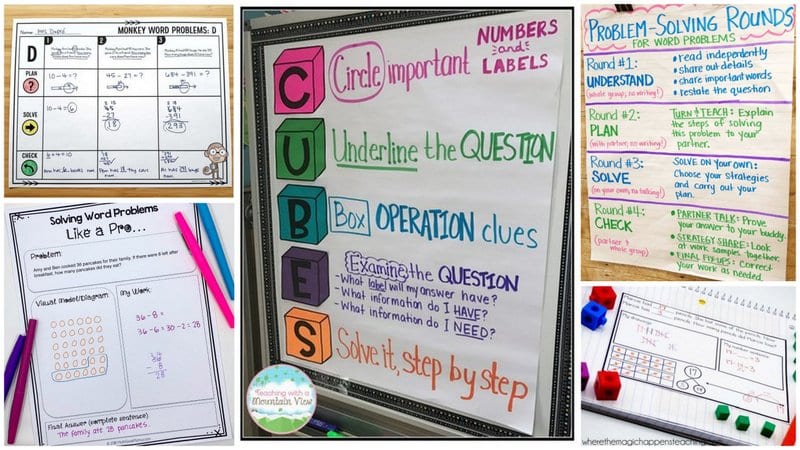
Word problems can be tricky for a lot of students, but they’re incredibly important to master. After all, in the real world, most math is in the form of word problems. “If one gallon of paint covers 400 square feet, and my wall measures 34 feet by 8 feet, how many gallons do I need?” “This sweater costs $135, but it’s on sale for 35% off. So how much is that?” Here are the best teacher-tested ideas for helping kids get a handle on these problems.
1. Solve word problems regularly
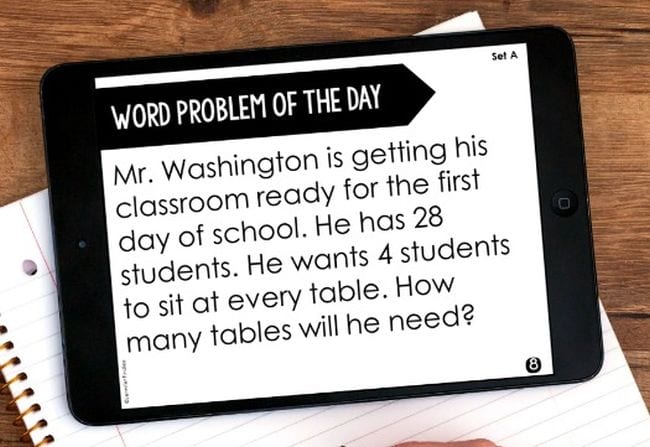
This might be the most important tip of all. Word problems should be part of everyday math practice, especially for older kids. Whenever possible, use word problems every time you teach a new math skill. Even better: give students a daily word problem to solve so they’ll get comfortable with the process.
Learn more: Teaching With Jennifer Findlay
2. Teach problem-solving routines
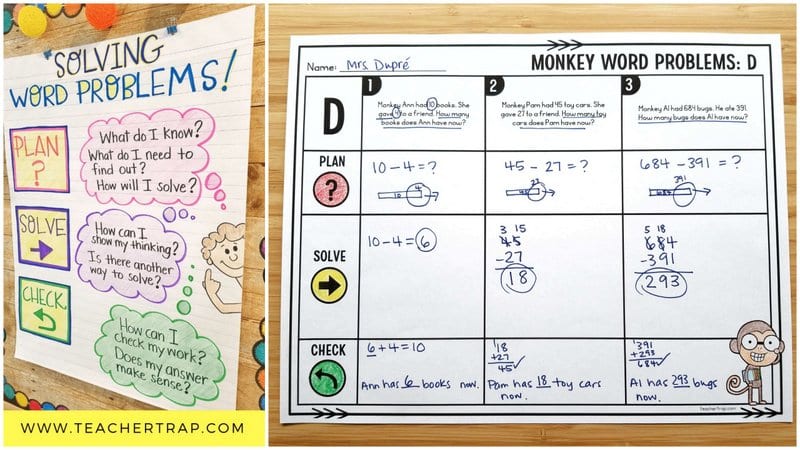
There are a LOT of strategies out there for teaching kids how to solve word problems (keep reading to see some terrific examples). The important thing to remember is that what works for one student may not work for another. So introduce a basic routine like Plan-Solve-Check that every kid can use every time. You can expand on the Plan and Solve steps in a variety of ways, but this basic 3-step process ensures kids slow down and take their time.
Learn more: Word Problems Made Easy
[contextly_auto_sidebar]
3. Visualize or model the problem
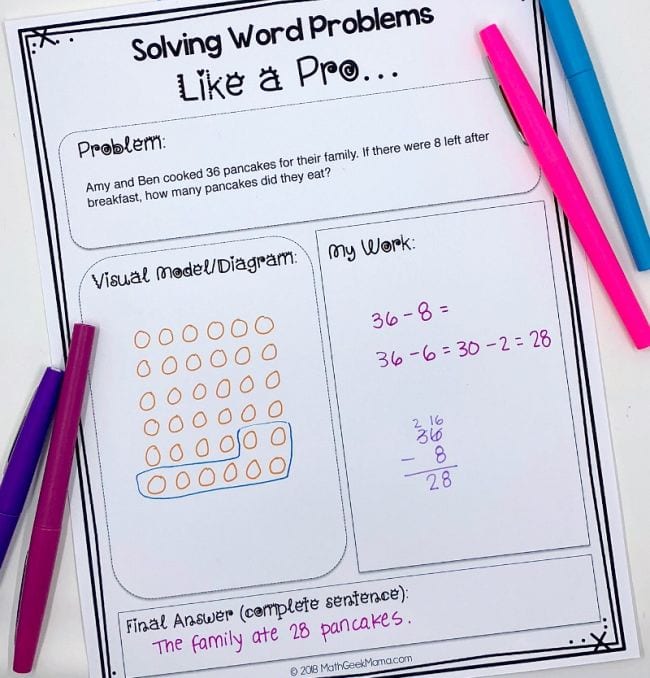
Encourage students to think of word problems as an actual story or scenario. Try acting the problem out if possible, and draw pictures, diagrams, or models. Learn more about this method and get free printable templates at the link.
Learn more: Math Geek Mama
4. Make sure they identify the actual question
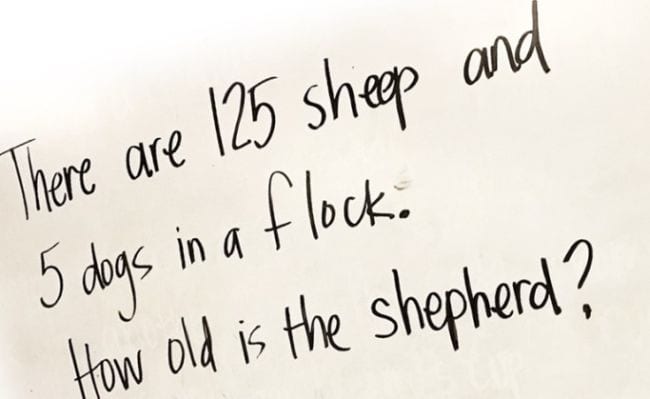
Educator Robert Kaplinsky asked 32 eighth grade students to answer this nonsensical word problem. Only 25% of them realized they didn’t have the right information to answer the actual question; the other 75% gave a variety of numerical answers that involved adding, subtracting, or dividing the two numbers. That tells us kids really need to be trained to identify the actual question being asked before they proceed.
Learn more: Robert Kaplinsky
5. Remove the numbers
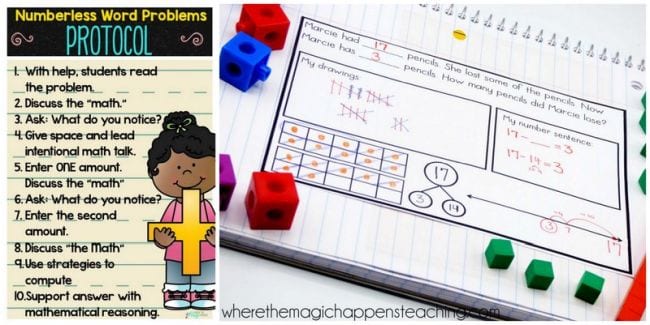
It seems counterintuitive … math without numbers? But this word problem strategy really forces kids to slow down and examine the problem itself, without focusing on numbers at first. If the numbers were removed from the sheep/shepherd problem above, students would have no choice but to slow down and read more carefully, rather than plowing ahead without thinking.
Learn more: Where the Magic Happens Teaching
6. Try the CUBES method
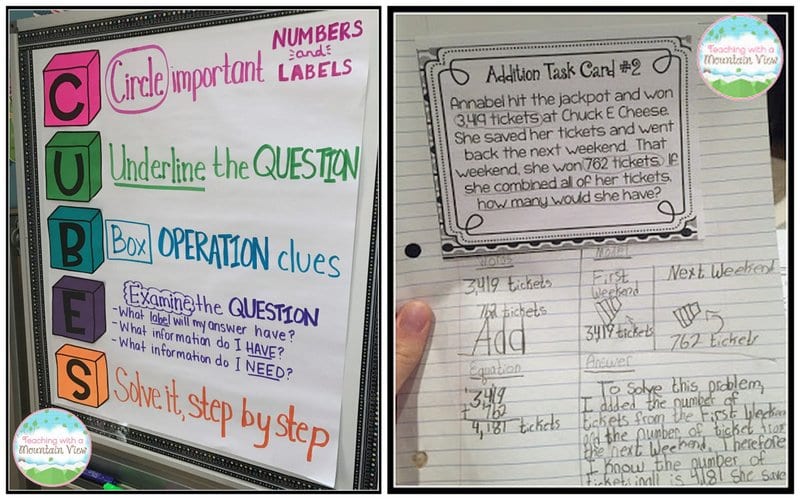
This is a tried-and-true method for teaching word problems, and it’s really effective for kids who are prone to working too fast and missing details. By taking the time to circle, box, and underline important information, students are more likely to find the correct answer to the question actually being asked.
Learn more: Teaching With a Mountain View
7. Show word problems the LOVE
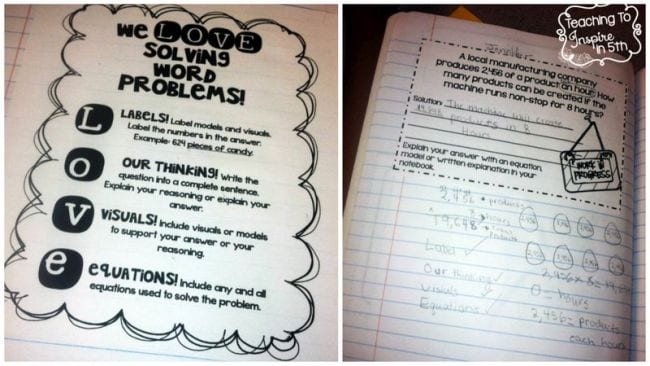
Here’s another fun acronym for tackling word problems: LOVE. Using this method, kids Label numbers and other key info, then explain Our thinking by writing the equation as a sentence. They use Visuals or models to help plan and list any and all Equations they’ll use.
8. Consider teaching word problem key words
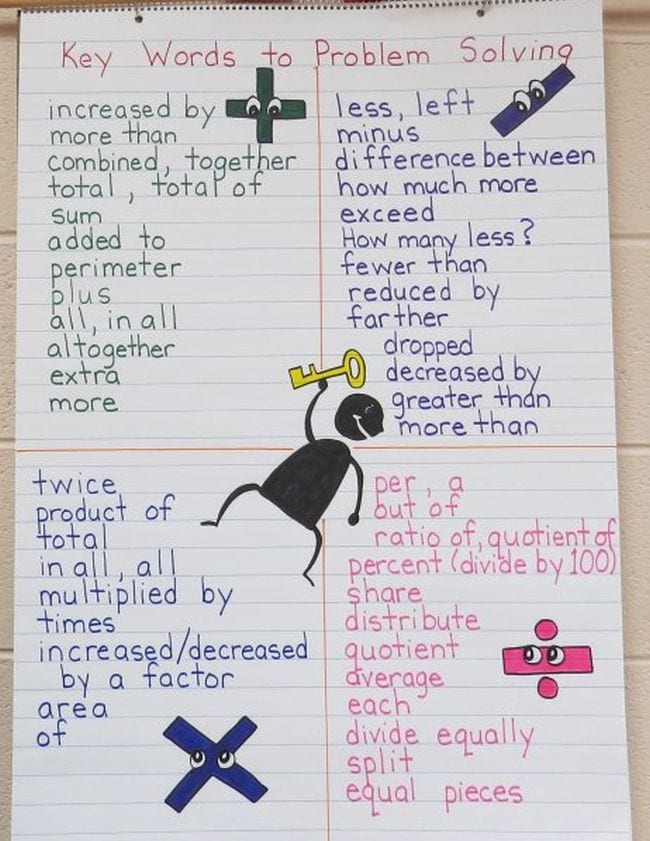
This is one of those methods that some teachers love and others hate. Those who like it feel it offers kids a simple tool for making sense of words and how they relate to math. Others feel it’s outdated, and prefer to teach word problems using context and situations instead (see below). You might just consider this one more trick to keep in your toolbox for students who need it.
Learn more: Book Units Teacher
9. Determine the operation for the situation
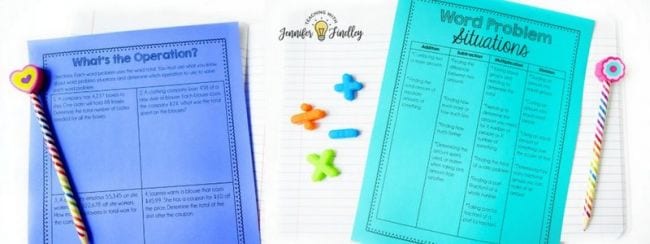
Instead of (or in addition to) key words, have kids really analyze the situation presented to determine the right operation(s) to use. Some key words, like “total,” can be pretty vague. It’s worth taking the time to dig deeper into what the problem is really asking. Get a free printable chart and learn how to use this method at the link.
Learn more: Solving Word Problems With Jennifer Findlay
10. Differentiate word problems to build skills
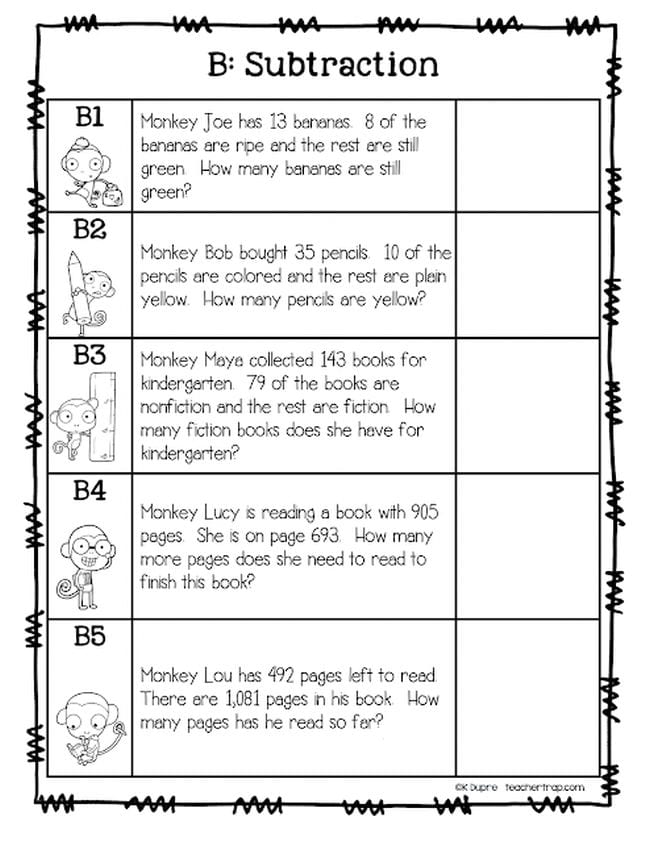
Sometimes students get so distracted by numbers that look big or scary that they give up right off the bat. For those cases, try working your way up to the skill at hand. For instance, instead of jumping right to subtracting 4 digit numbers, make the numbers smaller to start. Each successive problem can be a little more difficult, but kids will see they can use the same method regardless of the numbers themselves.
Learn more: Differentiating Math
11. Ensure they can justify their answers
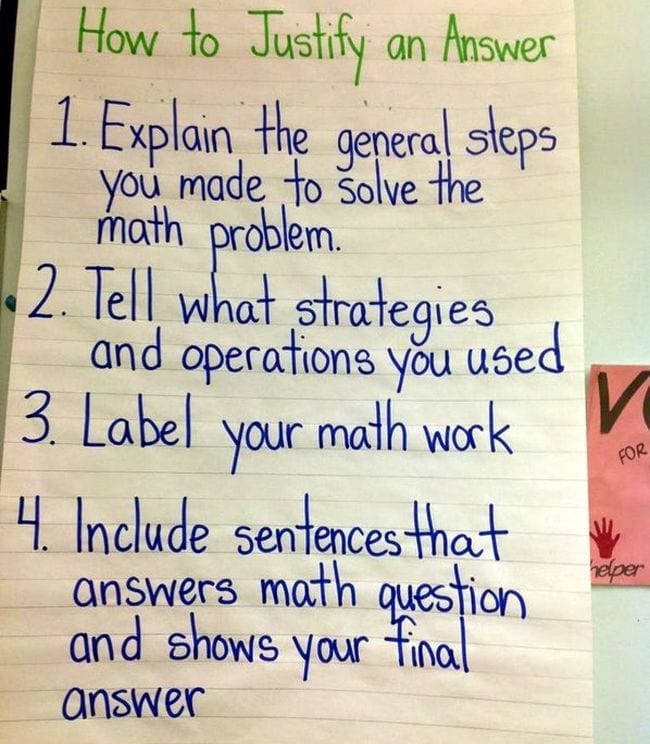
One of the quickest ways to find mistakes is to look closely at your answer and ensure it makes sense. If students can explain how they came to their conclusion, they’re much more likely to get the answer right. That’s why teachers have been asking students to “show their work” for decades now.
Learn more: Madly Learning
12. Write the answer in a sentence
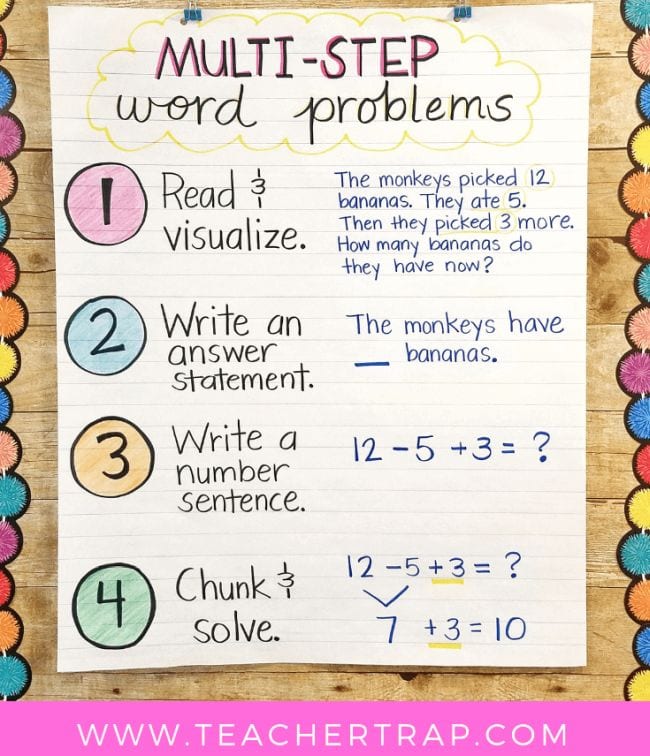
When you think about it, this one makes so much sense. Word problems are presented in complete sentences, so the answers should be too. This helps students make certain they’re actually answering the question being asked… part of justifying their answer.
Learn more: Multi-Step Word Problems
13. Add rigor to your word problems

A smart way to help kids conquer word problems is to, well… give them better problems to conquer. A rich math word problem is accessible and feels real to students, like something that matters. It should allow for different ways to solve it and be open for discussion. A series of problems should be varied, using different operations and situations when possible, and even include multiple steps. Visit both of the links below for excellent tips on adding rigor to your math word problems.
Learn more: The Routty Math Teacher and Alyssa Teaches
14. Use a problem-solving rounds activity.
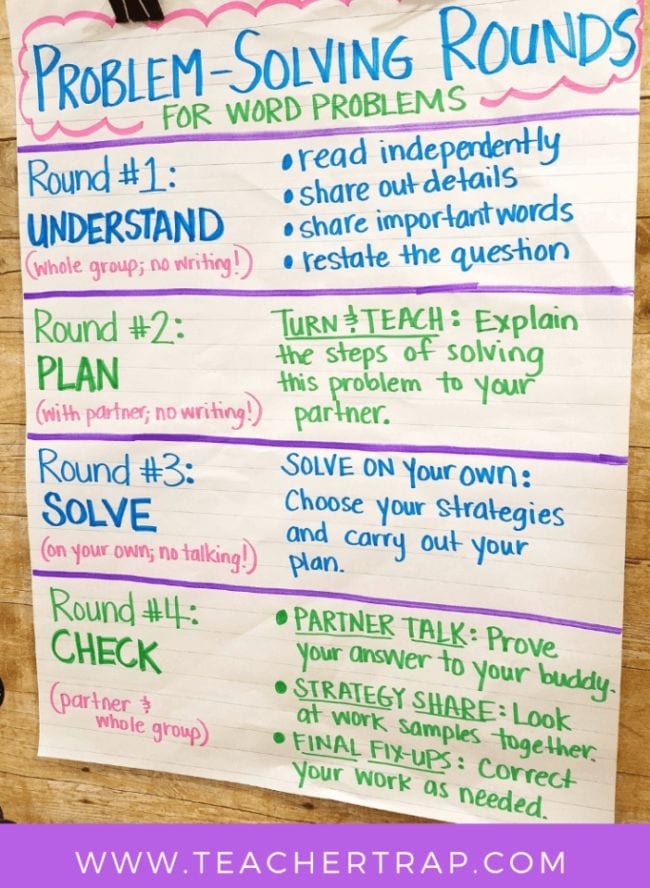
Put all those word problem strategies and skills together with this whole-class activity. Start by reading the problem as a group and sharing important information. Then, have students work with a partner to plan how they’ll solve it. In round three, kids use those plans to solve the problem individually. Finally, they share their answer and methods with their partner and the class. Be sure to recognize and respect all problem-solving strategies that lead to the correct answer.
Learn more: Teacher Trap
Like these word problem tips and tricks? Learn more about Why It’s Important to Honor All Math Strategies .
Plus, 60+ Awesome Websites For Teaching and Learning Math .
You Might Also Like
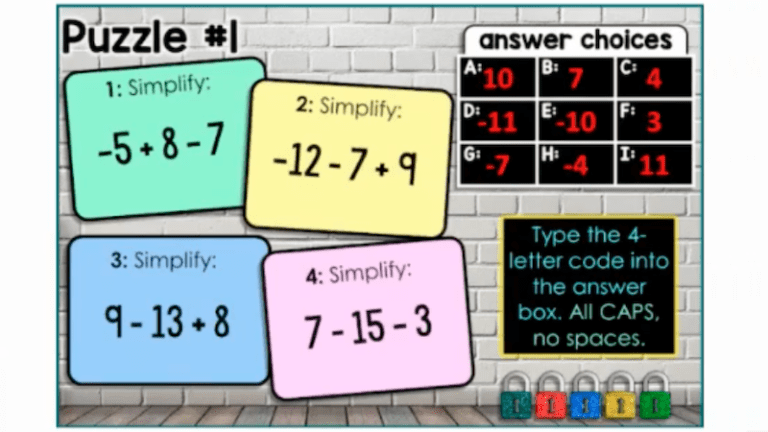
Digital Escape Rooms for Fun and Formative Assessment
Escape the monotony while racing the clock. Continue Reading
Copyright © 2024. All rights reserved. 5335 Gate Parkway, Jacksonville, FL 32256
Solving Word Questions
With LOTS of examples!
In Algebra we often have word questions like:

Example: Sam and Alex play tennis.
On the weekend Sam played 4 more games than Alex did, and together they played 12 games.
How many games did Alex play?
How do we solve them?
The trick is to break the solution into two parts:
Turn the English into Algebra.
Then use Algebra to solve.
Turning English into Algebra
To turn the English into Algebra it helps to:
- Read the whole thing first
- Do a sketch if possible
- Assign letters for the values
- Find or work out formulas
You should also write down what is actually being asked for , so you know where you are going and when you have arrived!
Also look for key words:
Thinking Clearly
Some wording can be tricky, making it hard to think "the right way around", such as:
Example: Sam has 2 dollars less than Alex. How do we write this as an equation?
- Let S = dollars Sam has
- Let A = dollars Alex has
Now ... is that: S − 2 = A
or should it be: S = A − 2
or should it be: S = 2 − A
The correct answer is S = A − 2
( S − 2 = A is a common mistake, as the question is written "Sam ... 2 less ... Alex")
Example: on our street there are twice as many dogs as cats. How do we write this as an equation?
- Let D = number of dogs
- Let C = number of cats
Now ... is that: 2D = C
or should it be: D = 2C
Think carefully now!
The correct answer is D = 2C
( 2D = C is a common mistake, as the question is written "twice ... dogs ... cats")
Let's start with a really simple example so we see how it's done:
Example: A rectangular garden is 12m by 5m, what is its area ?
Turn the English into Algebra:
- Use w for width of rectangle: w = 12m
- Use h for height of rectangle: h = 5m
Formula for Area of a Rectangle : A = w × h
We are being asked for the Area.
A = w × h = 12 × 5 = 60 m 2
The area is 60 square meters .
Now let's try the example from the top of the page:

Example: Sam and Alex play Tennis. On the weekend Sam played 4 more games than Alex did, and together they played 12 games. How many games did Alex play?
- Use S for how many games Sam played
- Use A for how many games Alex played
We know that Sam played 4 more games than Alex, so: S = A + 4
And we know that together they played 12 games: S + A = 12
We are being asked for how many games Alex played: A
Which means that Alex played 4 games of tennis.
Check: Sam played 4 more games than Alex, so Sam played 8 games. Together they played 8 + 4 = 12 games. Yes!
A slightly harder example:

Example: Alex and Sam also build tables. Together they make 10 tables in 12 days. Alex working alone can make 10 in 30 days. How long would it take Sam working alone to make 10 tables?
- Use a for Alex's work rate
- Use s for Sam's work rate
12 days of Alex and Sam is 10 tables, so: 12a + 12s = 10
30 days of Alex alone is also 10 tables: 30a = 10
We are being asked how long it would take Sam to make 10 tables.
30a = 10 , so Alex's rate (tables per day) is: a = 10/30 = 1/3
Which means that Sam's rate is half a table a day (faster than Alex!)
So 10 tables would take Sam just 20 days.
Should Sam be paid more I wonder?
And another "substitution" example:

Example: Jenna is training hard to qualify for the National Games. She has a regular weekly routine, training for five hours a day on some days and 3 hours a day on the other days. She trains altogether 27 hours in a seven day week. On how many days does she train for five hours?
- The number of "5 hour" days: d
- The number of "3 hour" days: e
We know there are seven days in the week, so: d + e = 7
And she trains 27 hours in a week, with d 5 hour days and e 3 hour days: 5d + 3e = 27
We are being asked for how many days she trains for 5 hours: d
The number of "5 hour" days is 3
Check : She trains for 5 hours on 3 days a week, so she must train for 3 hours a day on the other 4 days of the week.
3 × 5 hours = 15 hours, plus 4 × 3 hours = 12 hours gives a total of 27 hours
Some examples from Geometry:
Example: A circle has an area of 12 mm 2 , what is its radius?
- Use A for Area: A = 12 mm 2
- Use r for radius
And the formula for Area is: A = π r 2
We are being asked for the radius.
We need to rearrange the formula to find the area
Example: A cube has a volume of 125 mm 3 , what is its surface area?
Make a quick sketch:
- Use V for Volume
- Use A for Area
- Use s for side length of cube
- Volume of a cube: V = s 3
- Surface area of a cube: A = 6s 2
We are being asked for the surface area.
First work out s using the volume formula:
Now we can calculate surface area:
An example about Money:

Example: Joel works at the local pizza parlor. When he works overtime he earns 1¼ times the normal rate. One week Joel worked for 40 hours at the normal rate of pay and also worked 12 hours overtime. If Joel earned $660 altogether in that week, what is his normal rate of pay?
- Joel's normal rate of pay: $N per hour
- Joel works for 40 hours at $N per hour = $40N
- When Joel does overtime he earns 1¼ times the normal rate = $1.25N per hour
- Joel works for 12 hours at $1.25N per hour = $(12 × 1¼N) = $15N
- And together he earned $660, so:
$40N + $(12 × 1¼N) = $660
We are being asked for Joel's normal rate of pay $N.
So Joel’s normal rate of pay is $12 per hour
Joel’s normal rate of pay is $12 per hour, so his overtime rate is 1¼ × $12 per hour = $15 per hour. So his normal pay of 40 × $12 = $480, plus his overtime pay of 12 × $15 = $180 gives us a total of $660
More about Money, with these two examples involving Compound Interest
Example: Alex puts $2000 in the bank at an annual compound interest of 11%. How much will it be worth in 3 years?
This is the compound interest formula:
So we will use these letters:
- Present Value PV = $2,000
- Interest Rate (as a decimal): r = 0.11
- Number of Periods: n = 3
- Future Value (the value we want): FV
We are being asked for the Future Value: FV
Example: Roger deposited $1,000 into a savings account. The money earned interest compounded annually at the same rate. After nine years Roger's deposit has grown to $1,551.33 What was the annual rate of interest for the savings account?
The compound interest formula:
- Present Value PV = $1,000
- Interest Rate (the value we want): r
- Number of Periods: n = 9
- Future Value: FV = $1,551.33
We are being asked for the Interest Rate: r
So the annual rate of interest is 5%
Check : $1,000 × (1.05) 9 = $1,000 × 1.55133 = $1,551.33
And an example of a Ratio question:
Example: At the start of the year the ratio of boys to girls in a class is 2 : 1 But now, half a year later, four boys have left the class and there are two new girls. The ratio of boys to girls is now 4 : 3 How many students are there altogether now?
- Number of boys now: b
- Number of girls now: g
The current ratio is 4 : 3
Which can be rearranged to 3b = 4g
At the start of the year there was (b + 4) boys and (g − 2) girls, and the ratio was 2 : 1
b + 4 g − 2 = 2 1
Which can be rearranged to b + 4 = 2(g − 2)
We are being asked for how many students there are altogether now: b + g
There are 12 girls !
And 3b = 4g , so b = 4g/3 = 4 × 12 / 3 = 16 , so there are 16 boys
So there are now 12 girls and 16 boys in the class, making 28 students altogether .
There are now 16 boys and 12 girls, so the ratio of boys to girls is 16 : 12 = 4 : 3 At the start of the year there were 20 boys and 10 girls, so the ratio was 20 : 10 = 2 : 1
And now for some Quadratic Equations :
Example: The product of two consecutive even integers is 168. What are the integers?
Consecutive means one after the other. And they are even , so they could be 2 and 4, or 4 and 6, etc.
We will call the smaller integer n , and so the larger integer must be n+2
And we are told the product (what we get after multiplying) is 168, so we know:
n(n + 2) = 168
We are being asked for the integers
That is a Quadratic Equation , and there are many ways to solve it. Using the Quadratic Equation Solver we get −14 and 12.
Check −14: −14(−14 + 2) = (−14)×(−12) = 168 YES
Check 12: 12(12 + 2) = 12×14 = 168 YES
So there are two solutions: −14 and −12 is one, 12 and 14 is the other.
Note: we could have also tried "guess and check":
- We could try, say, n=10: 10(12) = 120 NO (too small)
- Next we could try n=12: 12(14) = 168 YES
But unless we remember that multiplying two negatives make a positive we might overlook the other solution of (−14)×(−12).
Example: You are an Architect. Your client wants a room twice as long as it is wide. They also want a 3m wide veranda along the long side. Your client has 56 square meters of beautiful marble tiles to cover the whole area. What should the length of the room be?
Let's first make a sketch so we get things right!:
- the length of the room: L
- the width of the room: W
- the total Area including veranda: A
- the width of the room is half its length: W = ½L
- the total area is the (room width + 3) times the length: A = (W+3) × L = 56
We are being asked for the length of the room: L
This is a quadratic equation , there are many ways to solve it, this time let's use factoring :
And so L = 8 or −14
There are two solutions to the quadratic equation, but only one of them is possible since the length of the room cannot be negative!
So the length of the room is 8 m
L = 8, so W = ½L = 4
So the area of the rectangle = (W+3) × L = 7 × 8 = 56
There we are ...
... I hope these examples will help you get the idea of how to handle word questions. Now how about some practice?
Introduction to Word Problems
These lessons, with videos, examples, solutions and worksheets, help Grade 5 students learn how to solve word problems.
Related Pages More Grade 5 Math Word Problems More Lessons for Grade 5 Math Math Worksheets
The following diagram gives some examples of word problems keywords or clue words. Scroll down the page for more examples and solutions of word problems.
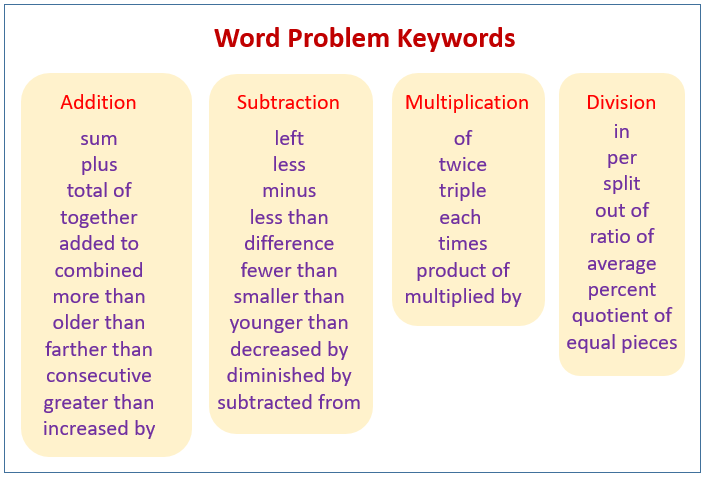
Introduction to Word Problem Terms
Problem Solving Strategies
Explain the meanings of the four basic operations–addition, subtraction, multiplication and division–so that you can understand how to solve word problems correctly.
Helpful hints for solving word problems

We welcome your feedback, comments and questions about this site or page. Please submit your feedback or enquiries via our Feedback page.

SOLVING WORD PROBLEMS: A VISUAL APPROACH: HOME

Step 1: Identify the given information in the problem.
Underline the information in your problem. Then create a checklist. As you use the information in your solution, make sure to check off each box.
Understanding a math word problem is 50% of the work. So give yourself a pat on the back when you’ve finished it!
Step 2: Find the question in the passage and state it in your own words.
Underline the question with a different color than you used for the first step. After you have underlined the question, write the information out in your own words, so that you understand what is being asked.
Step 3: Devise a strategy to solve the problem.
Now that you have collected the information you need to solve the problem, you need to come up with a strategy to conquer the problem.
Think about what’s being asked. Is there a formula you need to use? Do you need to calculate a percentage for your final answer? Write out the steps you need to use to solve the problem, so that you can carry out your plan.
THE STEPS TO SOLVING A WORD PROBLEM
- Identify the given information.
- Find the question and state it in your own words.
- Devise a strategy to solve the problem.
- Carry out your plan.
Use three different colored pencils/pens to separate each of the first three parts of the problem solving process.
Here are a few examples of how to use this process in solving a mathematical problem.
RATE THIS GUIDE
Ask the asc for help.
Need Academic Help? Contact the Academic Success Center (ASC)!

Step 4: Once you have created a plan, then you need to solve the problem. Make sure you have used all the given information in the problem, answered the question, and followed each step in your strategy.
Keep Calm. Be confident. You’ve got this!

- Last Updated: Nov 22, 2017 12:17 PM
- URL: https://guides.kendall.edu/wordproblems
MAKE WAVES WITH THIS FREE WEEKLONG VOCABULARY UNIT!

Strategies for Solving Word Problems – Math
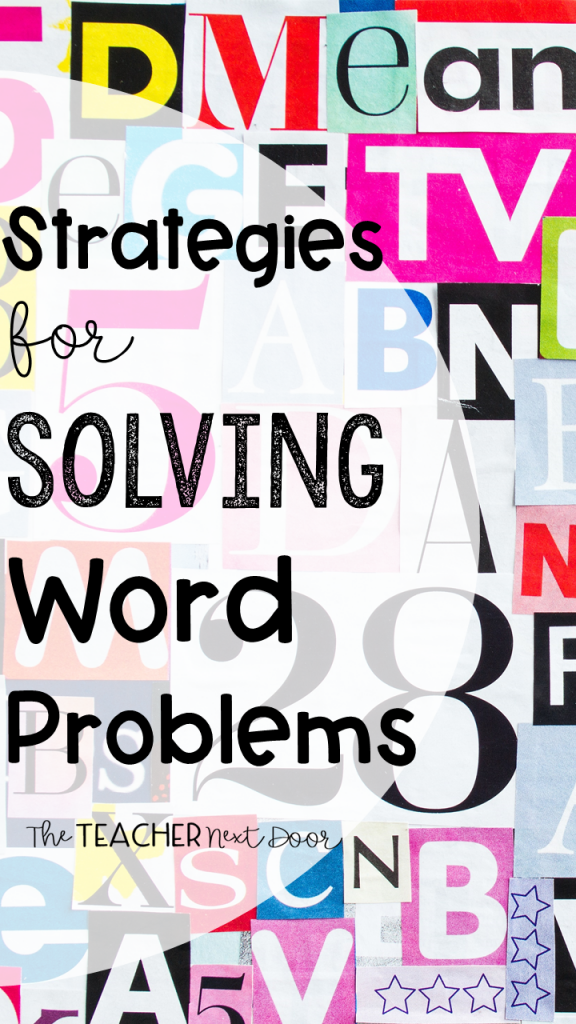
It’s one thing to solve a math equation when all of the numbers are given to you but with word problems, when you start adding reading to the mix, that’s when it gets especially tricky.
The simple addition of those words ramps up the difficulty (and sometimes the math anxiety) by about 100!
How can you help your students become confident word problem solvers? By teaching your students to solve word problems in a step by step, organized way, you will give them the tools they need to solve word problems in a much more effective way.
Here are the seven strategies I use to help students solve word problems.
1. read the entire word problem.
Before students look for keywords and try to figure out what to do, they need to slow down a bit and read the whole word problem once (and even better, twice). This helps kids get the bigger picture to be able to understand it a little better too.
2. Think About the Word Problem
Students need to ask themselves three questions every time they are faced with a word problem. These questions will help them to set up a plan for solving the problem.
Here are the questions:
A. what exactly is the question.
What is the problem asking? Often times, curriculum writers include extra information in the problem for seemingly no good reason, except maybe to train kids to ignore that extraneous information (grrrr!). Students need to be able to stay focused, ignore those extra details, and find out what the real question is in a particular problem.
B. What do I need in order to find the answer?
Students need to narrow it down, even more, to figure out what is needed to solve the problem, whether it’s adding, subtracting, multiplying, dividing, or some combination of those. They’ll need a general idea of which information will be used (or not used) and what they’ll be doing.
This is where key words become very helpful. When students learn to recognize that certain words mean to add (like in all, altogether, combined ), while others mean to subtract, multiply, or to divide, it helps them decide how to proceed a little better
Here’s a Key Words Chart I like to use for teaching word problems. The handout could be copied at a smaller size and glued into interactive math notebooks. It could be placed in math folders or in binders under the math section if your students use binders.
One year I made huge math signs (addition, subtraction, multiplication, and divide symbols) and wrote the keywords around the symbols. These served as a permanent reminder of keywords for word problems in the classroom.
If you’d like to download this FREE Key Words handout, click here:
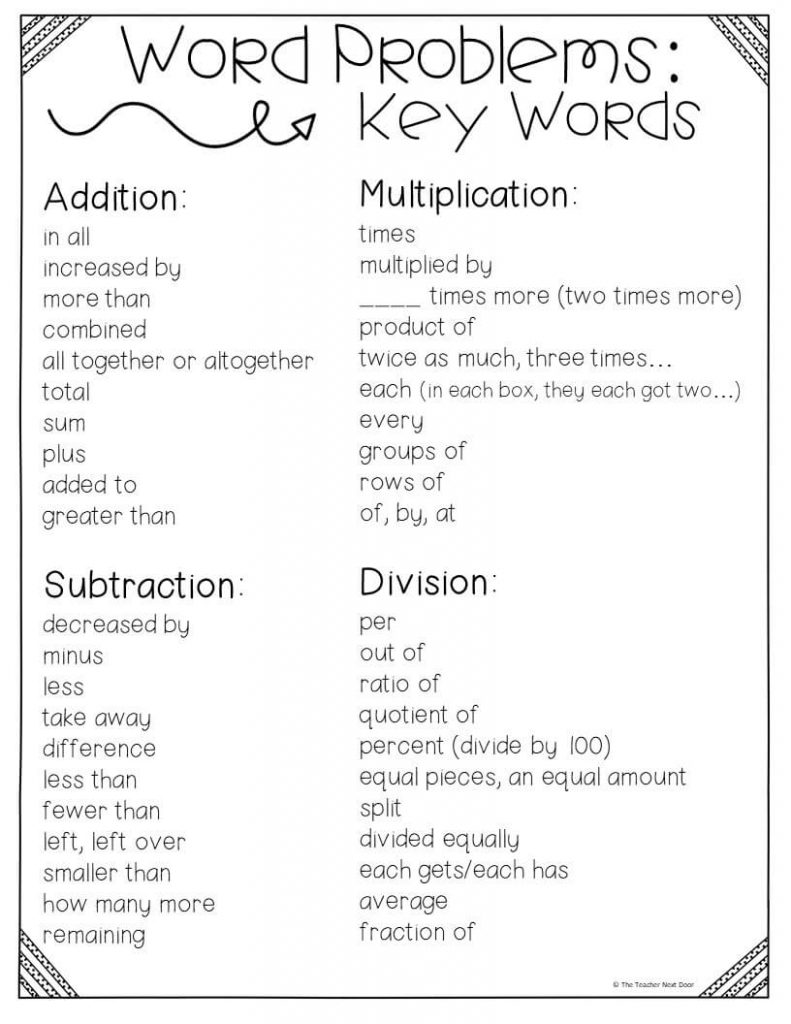
C. What information do I already have?
This is where students will focus in on the numbers which will be used to solve the problem.
3. Write on the Word Problem
This step reinforces the thinking which took place in step number two. Students use a pencil or colored pencils to notate information on worksheets (not books of course, unless they’re consumable). There are lots of ways to do this, but here’s what I like to do:
- Circle any numbers you’ll use.
- Lightly cross out any information you don’t need.
- Underline the phrase or sentence which tells exactly what you’ll need to find.
4. Draw a Simple Picture and Label It
Drawing pictures using simple shapes like squares, circles, and rectangles help students visualize problems. Adding numbers or names as labels help too.
For example, if the word problem says that there were five boxes and each box had 4 apples in it, kids can draw five squares with the number four in each square. Instantly, kids can see the answer so much more easily!
5. Estimate the Answer Before Solving
Having a general idea of a ballpark answer for the problem lets students know if their actual answer is reasonable or not. This quick, rough estimate is a good math habit to get into. It helps students really think about their answer’s accuracy when the problem is finally solved.
6. Check Your Work When Done
This strategy goes along with the fifth strategy. One of the phrases I constantly use during math time is, Is your answer reasonable ? I want students to do more than to be number crunchers but to really think about what those numbers mean.
Also, when students get into the habit of checking work, they are more apt to catch careless mistakes, which are often the root of incorrect answers.
7. Practice Word Problems Often
Just like it takes practice to learn to play the clarinet, to dribble a ball in soccer, and to draw realistically, it takes practice to become a master word problem solver.
When students practice word problems, often several things happen. Word problems become less scary (no, really).
They start to notice similarities in types of problems and are able to more quickly understand how to solve them. They will gain confidence even when dealing with new types of word problems, knowing that they have successfully solved many word problems in the past.
If you’re looking for some word problem task cards, I have quite a few of them for 3rd – 5th graders.
This 3rd grade math task cards bundle has word problems in almost every one of its 30 task card sets..
There are also specific sets that are dedicated to word problems and two-step word problems too. I love these because there’s a task card set for every standard.
CLICK HERE to take a look at 3rd grade:
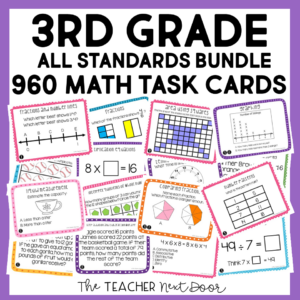
This 4th Grade Math Task Cards Bundle also has lots of word problems in almost every single of its 30 task card sets. These cards are perfect for centers, whole class, and for one on one.
CLICK HERE to see 4th grade:
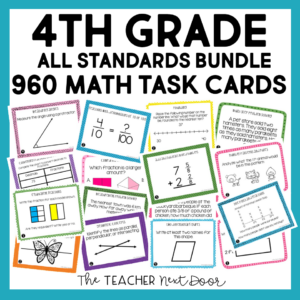
This 5th Grade Math Task Cards Bundle is also loaded with word problems to give your students focused practice.
CLICK HERE to take a look at 5th grade:
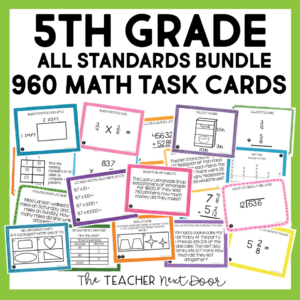
Want to try a FREE set of math task cards to see what you think?
3rd Grade: Rounding Whole Numbers Task Cards
4th Grade: Convert Fractions and Decimals Task Cards
5th Grade: Read, Write, and Compare Decimals Task Cards
Thanks so much for stopping by!

- Read more about: Math
You might also like...
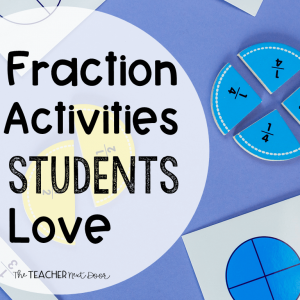
Fraction Activities Students Love – Math
Fractions can be tough! While it takes time and repeated exposure with fractions for students to have a real understanding of them, there are lots
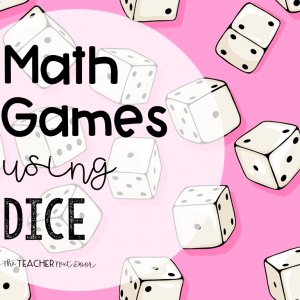
Math Games Using Dice
Games are an important part of math class, in my opinion. Not only are kids able to practice the skills that we have been focusing
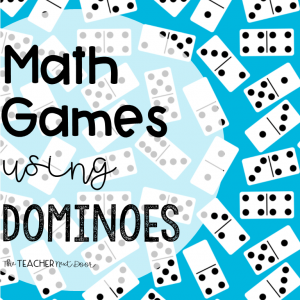
Math Games Using Dominoes
Math games have always been part of our math time. I love the fact that any time I introduce a math game, I know I’ll
Hi, I’m Jenn, CEO and owner of The Teacher Next Door!
I know that you strive to be an effective upper elementary teacher while maintaining a healthy work-life balance.
In order to do that, you need resources that are impactful, yet simple .
The problem is that most resources and curriculums out there are far from simple. The pages upon pages of daily lesson plans are just plain overwhelming .
At TTND, we believe teachers should be living their lives outside of the classroom, and not spend hours lesson planning and searching for resources.
We understand that now, more than ever, teachers need space to be themselves which is why we create and support teachers with timesaving tips and standards-aligned resources.
Want access to TTND's Free Resource Library? Sign up for our newsletter and we'll email you the exclusive password!
Trending posts.

SEARCH BY TOPIC
- Classroom Ideas
- Holidays and Seasonal
- Mentor Texts
- Reading Block
- Uncategorized
- Writing & Grammar
POPULAR RESOURCES

Facebook Group
Teachers Pay Teachers
Free Resource Library
💌 Contact Us
Disclosures
Privacy Policy
Refund Policy
Purchase Orders
Your Downloads
Reward Points
© The Teacher Next Door, LLC. All rights reserved.

* Please note: If your school has strong email filters, you may wish to use your personal email to ensure access.
- + ACCUPLACER Mathematics
- + ACT Mathematics
- + AFOQT Mathematics
- + ALEKS Tests
- + ASVAB Mathematics
- + ATI TEAS Math Tests
- + Common Core Math
- + DAT Math Tests
- + FSA Tests
- + FTCE Math
- + GED Mathematics
- + Georgia Milestones Assessment
- + GRE Quantitative Reasoning
- + HiSET Math Exam
- + HSPT Math
- + ISEE Mathematics
- + PARCC Tests
- + Praxis Math
- + PSAT Math Tests
- + PSSA Tests
- + SAT Math Tests
- + SBAC Tests
- + SIFT Math
- + SSAT Math Tests
- + STAAR Tests
- + TABE Tests
- + TASC Math
- + TSI Mathematics
- + ACT Math Worksheets
- + Accuplacer Math Worksheets
- + AFOQT Math Worksheets
- + ALEKS Math Worksheets
- + ASVAB Math Worksheets
- + ATI TEAS 6 Math Worksheets
- + FTCE General Math Worksheets
- + GED Math Worksheets
- + 3rd Grade Mathematics Worksheets
- + 4th Grade Mathematics Worksheets
- + 5th Grade Mathematics Worksheets
- + 6th Grade Math Worksheets
- + 7th Grade Mathematics Worksheets
- + 8th Grade Mathematics Worksheets
- + 9th Grade Math Worksheets
- + HiSET Math Worksheets
- + HSPT Math Worksheets
- + ISEE Middle-Level Math Worksheets
- + PERT Math Worksheets
- + Praxis Math Worksheets
- + PSAT Math Worksheets
- + SAT Math Worksheets
- + SIFT Math Worksheets
- + SSAT Middle Level Math Worksheets
- + 7th Grade STAAR Math Worksheets
- + 8th Grade STAAR Math Worksheets
- + THEA Math Worksheets
- + TABE Math Worksheets
- + TASC Math Worksheets
- + TSI Math Worksheets
- + AFOQT Math Course
- + ALEKS Math Course
- + ASVAB Math Course
- + ATI TEAS 6 Math Course
- + CHSPE Math Course
- + FTCE General Knowledge Course
- + GED Math Course
- + HiSET Math Course
- + HSPT Math Course
- + ISEE Upper Level Math Course
- + SHSAT Math Course
- + SSAT Upper-Level Math Course
- + PERT Math Course
- + Praxis Core Math Course
- + SIFT Math Course
- + 8th Grade STAAR Math Course
- + TABE Math Course
- + TASC Math Course
- + TSI Math Course
- + Number Properties Puzzles
- + Algebra Puzzles
- + Geometry Puzzles
- + Intelligent Math Puzzles
- + Ratio, Proportion & Percentages Puzzles
- + Other Math Puzzles
How to Solve Multi-Step Word Problems
Multi-step word problems may initially seem daunting, but with a structured approach, they become manageable and less intimidating. Here, we provide a step-by-step guide to help you navigate these complex problems with ease.
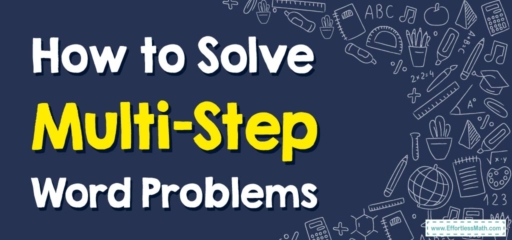
A Step-by-step Guide to Solving Multi-Step Word Problems
Step 1: understand the problem.
The first step in solving multi-step word problems is to read the problem carefully. Look for keywords and phrases that suggest what arithmetic operation(s) you will need to apply. Words like ‘in total’, ‘altogether’ or ‘sum’ suggest an addition, ‘less than’ or ‘remain’ hint towards subtraction, ‘product’ or ‘times’ indicate multiplication, and ‘quotient’ or ‘divided by’ point to division.
Step 2: Identify the Steps Needed
After understanding the problem, list out the necessary steps to reach the solution. Each word problem is a unique puzzle with its sequence of operations. Some problems may require you to perform multiplication before addition, while others may need subtraction followed by division.
Step 3: Assign Variables
For problems with unknown quantities, assign a variable (for example, \(X\) or \(Y\)) to each unknown. This strategy makes it easier to organize information and apply arithmetic operations.
Step 4: Write Equations
Formulate equations based on the identified steps and assigned variables. Keep in mind the order of operations (BIDMAS/BODMAS) – Brackets, Indices/Orders, Division and Multiplication (from left to right), Addition, and Subtraction (from left to right).
Step 5: Solve the Equations
Solving the equations might require simple substitution or more advanced techniques like elimination or matrix method in the case of multiple variables. Don’t forget to check your solutions to make sure they satisfy the original equations.
Step 6: Answer the Question
Finally, ensure that your answer responds to the question asked in the problem. For example, if the problem is asking for the total number of apples, your answer should be a number and mention ‘apples’.
Practical Example
Let’s apply these steps to a sample problem: “Sarah bought \(2\) books. Each book cost twice as much as a pen. She bought \(4\) pens. If each pen cost \($5\), how much did she spend in total?”
Step 1: The problem involves multiplication (each book cost twice as much as a pen) and addition (total amount spent).
Step 2: First, find the cost of a book and then calculate the total cost.
Step 3: Let’s say \(X\) is the cost of a book.
Step 4: The equations will be \(X = 2 \times the\:cost\:of\:a\:pen\) and Total cost = cost of books + cost of pens.
Step 5: Substituting the given cost of a pen (\($5\)), we find \(X = $10\). The total cost is then calculated as \((2 \times $10) + (4 \times $5) = $40\).
Step 6: The total amount Sarah spent is \($40\).
In conclusion, with a systematic approach, you can effectively solve any multi-step word problem. Remember, practice is the key. The more problems you solve, the better you will become at identifying the necessary steps and solving them accurately.
by: Effortless Math Team about 10 months ago (category: Articles )
Effortless Math Team
Related to this article, more math articles.
- Using Models to Represent Decimal Number Place Value
- How to Find the Scale Factor of a Dilation?
- ACT Math- Test Day Tips
- 7th Grade MCAP Math Worksheets: FREE & Printable
- PERT Math – Test Day Tips
- 6th Grade Common Core Math Worksheets: FREE & Printable
- Understanding Line Segments and Their Measurements
- 8th Grade Georgia Milestones Assessment System Math FREE Sample Practice Questions
- How to Solve an Absolute Value Inequality?
- How to Break Fractions and Mixed Numbers Apart to Add or Subtract
What people say about "How to Solve Multi-Step Word Problems - Effortless Math: We Help Students Learn to LOVE Mathematics"?
No one replied yet.
Leave a Reply Cancel reply
You must be logged in to post a comment.
AP Pre-Calculus for Beginners The Ultimate Step by Step Guide to Acing AP Precalculus
Pre-calculus for beginners the ultimate step by step guide to acing precalculus, mastering grade 6 math word problems the ultimate guide to tackling 6th grade math word problems, mastering grade 5 math word problems the ultimate guide to tackling 5th grade math word problems, mastering grade 7 math word problems the ultimate guide to tackling 7th grade math word problems, mastering grade 2 math word problems the ultimate guide to tackling 2nd grade math word problems, mastering grade 8 math word problems the ultimate guide to tackling 8th grade math word problems, mastering grade 4 math word problems the ultimate guide to tackling 4th grade math word problems, mastering grade 3 math word problems the ultimate guide to tackling 3rd grade math word problems, m-step grade 6 math for beginners the ultimate step by step guide to preparing for the m-step math test, fsa mathematics workbook for grade 6 step-by-step guide to preparing for the fsa math test 2019, fsa mathematics workbook for grade 7 step-by-step guide to preparing for the fsa math test 2019, fsa mathematics workbook for grade 5 step-by-step guide to preparing for the fsa math test 2019, fsa mathematics workbook for grade 4 step-by-step guide to preparing for the fsa math test 2019, fsa mathematics workbook for grade 3 step-by-step guide to preparing for the fsa math test 2019.
- ATI TEAS 6 Math
- ISEE Upper Level Math
- SSAT Upper-Level Math
- Praxis Core Math
- 8th Grade STAAR Math
Limited time only!
Save Over 45 %
It was $89.99 now it is $49.99
Login and use all of our services.
Effortless Math services are waiting for you. login faster!
Register Fast!
Password will be generated automatically and sent to your email.
After registration you can change your password if you want.
- Math Worksheets
- Math Courses
- Math Topics
- Math Puzzles
- Math eBooks
- GED Math Books
- HiSET Math Books
- ACT Math Books
- ISEE Math Books
- ACCUPLACER Books
- Premium Membership
- Youtube Videos
Effortless Math provides unofficial test prep products for a variety of tests and exams. All trademarks are property of their respective trademark owners.
- Bulk Orders
- Refund Policy
Module 9: Multi-Step Linear Equations
Apply a problem-solving strategy to basic word problems, learning outcomes.
- Practice mindfulness with your attitude about word problems
- Apply a general problem-solving strategy to solve word problems
Approach Word Problems with a Positive Attitude
The world is full of word problems. How much money do I need to fill the car with gas? How much should I tip the server at a restaurant? How many socks should I pack for vacation? How big a turkey do I need to buy for Thanksgiving dinner, and what time do I need to put it in the oven? If my sister and I buy our mother a present, how much will each of us pay?
Now that we can solve equations, we are ready to apply our new skills to word problems. Do you know anyone who has had negative experiences in the past with word problems? Have you ever had thoughts like the student in the cartoon below?

Negative thoughts about word problems can be barriers to success.
When we feel we have no control, and continue repeating negative thoughts, we set up barriers to success. We need to calm our fears and change our negative feelings.
Start with a fresh slate and begin to think positive thoughts like the student in the cartoon below. Read the positive thoughts and say them out loud.

When it comes to word problems, a positive attitude is a big step toward success.
If we take control and believe we can be successful, we will be able to master word problems.
Think of something that you can do now but couldn’t do three years ago. Whether it’s driving a car, snowboarding, cooking a gourmet meal, or speaking a new language, you have been able to learn and master a new skill. Word problems are no different. Even if you have struggled with word problems in the past, you have acquired many new math skills that will help you succeed now!
Use a Problem-Solving Strategy for Word Problems
In earlier chapters, you translated word phrases into algebraic expressions, using some basic mathematical vocabulary and symbols. Since then you’ve increased your math vocabulary as you learned about more algebraic procedures, and you’ve had more practice translating from words into algebra.
You have also translated word sentences into algebraic equations and solved some word problems. The word problems applied math to everyday situations. You had to restate the situation in one sentence, assign a variable, and then write an equation to solve. This method works as long as the situation is familiar to you and the math is not too complicated.
Now we’ll develop a strategy you can use to solve any word problem. This strategy will help you become successful with word problems. We’ll demonstrate the strategy as we solve the following problem.
Pete bought a shirt on sale for $[latex]18[/latex], which is one-half the original price. What was the original price of the shirt?
Solution: Step 1. Read the problem. Make sure you understand all the words and ideas. You may need to read the problem two or more times. If there are words you don’t understand, look them up in a dictionary or on the Internet.
- In this problem, do you understand what is being discussed? Do you understand every word?
Step 2. Identify what you are looking for. It’s hard to find something if you are not sure what it is! Read the problem again and look for words that tell you what you are looking for!
- In this problem, the words “what was the original price of the shirt” tell you what you are looking for: the original price of the shirt.
Step 3. Name what you are looking for. Choose a variable to represent that quantity. You can use any letter for the variable, but it may help to choose one that helps you remember what it represents.
- Let [latex]p=[/latex] the original price of the shirt
Step 4. Translate into an equation. It may help to first restate the problem in one sentence, with all the important information. Then translate the sentence into an equation.

Step 6. Check the answer in the problem and make sure it makes sense.
- We found that [latex]p=36[/latex], which means the original price was [latex]\text{\$36}[/latex]. Does [latex]\text{\$36}[/latex] make sense in the problem? Yes, because [latex]18[/latex] is one-half of [latex]36[/latex], and the shirt was on sale at half the original price.
Step 7. Answer the question with a complete sentence.
- The problem asked “What was the original price of the shirt?” The answer to the question is: “The original price of the shirt was [latex]\text{\$36}[/latex].”
If this were a homework exercise, our work might look like this:

We list the steps we took to solve the previous example.
Problem-Solving Strategy
- Read the word problem. Make sure you understand all the words and ideas. You may need to read the problem two or more times. If there are words you don’t understand, look them up in a dictionary or on the internet.
- Identify what you are looking for.
- Name what you are looking for. Choose a variable to represent that quantity.
- Translate into an equation. It may be helpful to first restate the problem in one sentence before translating.
- Solve the equation using good algebra techniques.
- Check the answer in the problem. Make sure it makes sense.
- Answer the question with a complete sentence.
For a review of how to translate algebraic statements into words, watch the following video.
Let’s use this approach with another example.
Yash brought apples and bananas to a picnic. The number of apples was three more than twice the number of bananas. Yash brought [latex]11[/latex] apples to the picnic. How many bananas did he bring?
In the next example, we will apply our Problem-Solving Strategy to applications of percent.
Nga’s car insurance premium increased by [latex]\text{\$60}[/latex], which was [latex]\text{8%}[/latex] of the original cost. What was the original cost of the premium?
- Write Algebraic Expressions from Statements: Form ax+b and a(x+b). Authored by : James Sousa (Mathispower4u.com) for Lumen Learning. Located at : https://youtu.be/Hub7ku7UHT4 . License : CC BY: Attribution
- Question ID 142694, 142722, 142735, 142761. Authored by : Lumen Learning. License : CC BY: Attribution . License Terms : IMathAS Community License, CC-BY + GPL
- Prealgebra. Provided by : OpenStax. License : CC BY: Attribution . License Terms : Download for free at http://cnx.org/contents/[email protected]


Strategies for Solving Math Word Problems
Math word problems can be tricky and often challenging to solve. Employing the SQRQCQ method can make solving math word problems easier and less intimidating.
The SQRQCQ method is particularly useful for children with learning disabilities and can be used effectively in special education programs. SQRQCQ is an abbreviation for Survey, Question, Read, Question, Compute, and Question.
Step 1 – SURVEY the Math Problem
The first step to solving a math word problem is to read the problem in its entirety to understand what you are being asked to solve. After you read it, you can decide the most relevant aspects of the problem that need to be solved and what aspects are not relevant to solving the problem. The idea here is to get a general understanding.
Step 2 – QUESTION
Once you have an idea of what you’re attempting to solve, you need to determine what formulas, steps, or equations should be utilized in order to find the correct answer. It is impossible to find an answer if you can’t determine what needs to be solved. Basically, what are the questions being asked by the problem?
Step 3 – REREAD
Now that you’ve determined what needs to be solved, reread the problem and pay close attention to specific details. Determine which aspects of the problem are interrelated. Identify all relevant facts and information needed to solve the problem. As you do, write them down.
Step 4 – QUESTION
Now that you’re familiar with specific details and how different facts and information within the problem are interrelated, determine what formulas or equations must be used to set up and solve the problem. Be sure to write down what steps or operations you will use for easy reference.
Step 5 – COMPUTE
Use the formulas and/or equations identified in the previous step to complete the calculations. Be sure to follow the steps you outlined while setting up an equation or using a formula. As you complete each step, check it off your list.
Step 6 – QUESTION
Once you’ve completed the calculations, review the final answer and make sure it is correct and accurate. If it does not appear logical, review the steps you took to find the answer and look for calculation or set-up errors. Recalculate the numbers or make other changes until you get an answer that makes sense.
How does SQRQCQ help students with learning disabilities?
Math word problems tend to be especially challenging for Learning Disabled (LD) students. LD students often lack “Concept Imagery”, or the ability to visualize the whole problem by creating a complete mental image. They often jump right into calculations and computations without understanding what the problem is asking or what they’re looking for.
LD students may also struggle to understand the words or wording within math word problems correctly. The inability to correctly interpret and understand wording greatly impacts their math reasoning skills and often leads them to making the wrong calculations and arriving incorrect conclusions.
Remembering and manipulating information and details in their working memory is another challenge some LD students face as they try to see the whole picture. Slow processing of information, followed by frustration and anxiety, will often lead LD students to try and get through math word problems as quickly as possible – which is why they often jump straight into computations in their attempt to make it to the finish line as quickly as possible.
SQRQCQ is a metacognitive guide that provides LD students with a logical order for solving math word problems. It provides just enough direction to guide them through the reasoning process without overwhelming them. SQRQCQ is also a mnemonic that is easy for students to remember and which they can fall back on when completing homework or taking tests.
Read also: – A Guide for St u dying Math
Similar Posts:
- Discover Your Learning Style – Comprehensive Guide on Different Learning Styles
- 15 Learning Theories in Education (A Complete Summary)
- 35 of the BEST Educational Apps for Teachers (Updated 2024)
Leave a Comment Cancel reply
Save my name and email in this browser for the next time I comment.
Word Problem Calculator
Get detailed solutions to your math problems with our word problem step-by-step calculator . practice your math skills and learn step by step with our math solver. check out all of our online calculators here ., example, solved problems, difficult problems, are you struggling with math.
Access detailed step by step solutions to thousands of problems, growing every day!
Popular problems
Most popular problems solved with this calculator:
Want Better Math Grades?
✅ Unlimited Solutions
✅ Step-by-Step Answers
✅ Available 24/7
➕ Free Bonuses ($1085 value!)
On this page
- Search IntMath
- Math interactives
- About (site info)
- Uses of Trignometry
- ASCIIMath input, KaTeX output
- ASCIIMath input, LaTeX and KaTeX output
- Send Math in emails
- Syntax for ASCIIMathML
- Math Display Experiments
- Scientific Notebook
Math Problem Solver
Related Sections
Math Tutoring
Need help? Chat with a tutor anytime, 24/7.

This tool combines the power of mathematical computation engine that excels at solving mathematical formulas with the power of artificial intelligence large language models to parse and generate natural language answers. This creates a math problem solver that's more accurate than ChatGPT, more flexible than a math calculator, and provides answers faster than a human tutor.
Sign up for free here .
Problem Solver Subjects
Our math problem solver that lets you input a wide variety of math math problems and it will provide a step by step answer. This math solver excels at math word problems as well as a wide range of math subjects.
- Math Word Problems
- Pre-Algebra
- Geometry Graphing
- Trigonometry
- Precalculus
- Finite Math
- Linear Algebra
Here are example math problems within each subject that can be input into the calculator and solved. This list is constanstly growing as functionality is added to the calculator.
Basic Math Solutions
Below are examples of basic math problems that can be solved.
- Long Arithmetic
- Rational Numbers
- Operations with Fractions
- Ratios, Proportions, Percents
- Measurement, Area, and Volume
- Factors, Fractions, and Exponents
- Unit Conversions
- Data Measurement and Statistics
- Points and Line Segments
Math Word Problem Solutions
Math word problems require interpreting what is being asked and simplifying that into a basic math equation. Once you have the equation you can then enter that into the problem solver as a basic math or algebra question to be correctly solved. Below are math word problem examples and their simplified forms.
Word Problem: Rachel has 17 apples. She gives some to Sarah. Sarah now has 8 apples. How many apples did Rachel give her?
Simplified Equation: 17 - x = 8
Word Problem: Rhonda has 12 marbles more than Douglas. Douglas has 6 marbles more than Bertha. Rhonda has twice as many marbles as Bertha has. How many marbles does Douglas have?
Variables: Rhonda's marbles is represented by (r), Douglas' marbles is represented by (d) and Bertha's marbles is represented by (b)
Simplified Equation: {r = d + 12, d = b + 6, r = 2 �� b}
Word Problem: if there are 40 cookies all together and Angela takes 10 and Brett takes 5 how many are left?
Simplified: 40 - 10 - 5
Pre-Algebra Solutions
Below are examples of Pre-Algebra math problems that can be solved.
- Variables, Expressions, and Integers
- Simplifying and Evaluating Expressions
- Solving Equations
- Multi-Step Equations and Inequalities
- Ratios, Proportions, and Percents
- Linear Equations and Inequalities
Algebra Solutions
Below are examples of Algebra math problems that can be solved.
- Algebra Concepts and Expressions
- Points, Lines, and Line Segments
- Simplifying Polynomials
- Factoring Polynomials
- Linear Equations
- Absolute Value Expressions and Equations
- Radical Expressions and Equations
- Systems of Equations
- Quadratic Equations
- Inequalities
- Complex Numbers and Vector Analysis
- Logarithmic Expressions and Equations
- Exponential Expressions and Equations
- Conic Sections
- Vector Spaces
- 3d Coordinate System
- Eigenvalues and Eigenvectors
- Linear Transformations
- Number Sets
- Analytic Geometry
Trigonometry Solutions
Below are examples of Trigonometry math problems that can be solved.
- Algebra Concepts and Expressions Review
- Right Triangle Trigonometry
- Radian Measure and Circular Functions
- Graphing Trigonometric Functions
- Simplifying Trigonometric Expressions
- Verifying Trigonometric Identities
- Solving Trigonometric Equations
- Complex Numbers
- Analytic Geometry in Polar Coordinates
- Exponential and Logarithmic Functions
- Vector Arithmetic
Precalculus Solutions
Below are examples of Precalculus math problems that can be solved.
- Operations on Functions
- Rational Expressions and Equations
- Polynomial and Rational Functions
- Analytic Trigonometry
- Sequences and Series
- Analytic Geometry in Rectangular Coordinates
- Limits and an Introduction to Calculus
Calculus Solutions
Below are examples of Calculus math problems that can be solved.
- Evaluating Limits
- Derivatives
- Applications of Differentiation
- Applications of Integration
- Techniques of Integration
- Parametric Equations and Polar Coordinates
- Differential Equations
Statistics Solutions
Below are examples of Statistics problems that can be solved.
- Algebra Review
- Average Descriptive Statistics
- Dispersion Statistics
- Probability
- Probability Distributions
- Frequency Distribution
- Normal Distributions
- t-Distributions
- Hypothesis Testing
- Estimation and Sample Size
- Correlation and Regression
Finite Math Solutions
Below are examples of Finite Math problems that can be solved.
- Polynomials and Expressions
- Equations and Inequalities
- Linear Functions and Points
- Systems of Linear Equations
- Mathematics of Finance
- Statistical Distributions
Linear Algebra Solutions
Below are examples of Linear Algebra math problems that can be solved.
- Introduction to Matrices
- Linear Independence and Combinations
Chemistry Solutions
Below are examples of Chemistry problems that can be solved.
- Unit Conversion
- Atomic Structure
- Molecules and Compounds
- Chemical Equations and Reactions
- Behavior of Gases
- Solutions and Concentrations
Physics Solutions
Below are examples of Physics math problems that can be solved.
- Static Equilibrium
- Dynamic Equilibrium
- Kinematics Equations
- Electricity
- Thermodymanics
Geometry Graphing Solutions
Below are examples of Geometry and graphing math problems that can be solved.
- Step By Step Graphing
- Linear Equations and Functions
- Polar Equations
Looking for the old Mathway Calculator? We've moved it to here .
Tips, tricks, lessons, and tutoring to help reduce test anxiety and move to the top of the class.
Email Address Sign Up

IMAGES
VIDEO
COMMENTS
Steps to Solving Word Problems in Mathematics. We are ready to SOLVE any word problem our students are going to encounter in math class. Here are my 5 easy steps to SOLVE any word problem in math: S - State the objective. O - Outline your plan. L - Look for Key Details - Information. V - Verify and Solve.
A Guide on Steps to Solving Word Problems: 10 Strategies. 1. Understand the Problem by Paraphrasing. One of the first steps in tackling a math word problem is to make sure your students understand what the problem is asking. Encourage them to paraphrase the problem in their own words.
Step 2: Highlight the keywords in the word problem. The keywords for word problems in math indicate what math action should be taken. Teach your child to highlight or underline the keywords in every word problem. Here are some of the most common keywords in math word problems: Subtraction words- less than, minus, take away.
Let's solve this problem step by step. We'll solve it the same way we solved the problem on page 1. Step 1: Read through the problem carefully. The first in solving any word problem is to find out what question the problem is asking you to solve and identify the information that will help you solve it. Let's look at the problem again.
Five Easy Steps to Solving Word Problems (WASSP) Write (or draw) what you know. Ask the question. Set up a math problem that could answer the question. Solve the math problem to get an answer. Put the answer in a sentence to see if the answer makes sense! Let's look at an example word problem to demonstrate these steps.
Algebraic word problems are questions that require translating sentences to equations, then solving those equations. The equations we need to write will only involve. basic arithmetic operations. and a single variable. Usually, the variable represents an unknown quantity in a real-life scenario.
An age problem is a type of word problem in math that involves calculating the age of one or more people at a specific point in time. These problems often use phrases such as 'x years ago,' 'in y years,' or 'y years later,' which indicate that the problem is related to time and age.
3. Visualize or model the problem. Encourage students to think of word problems as an actual story or scenario. Try acting the problem out if possible, and draw pictures, diagrams, or models. Learn more about this method and get free printable templates at the link. Learn more: Math Geek Mama. 4.
Turning English into Algebra. To turn the English into Algebra it helps to: Read the whole thing first; Do a sketch if possible; Assign letters for the values; Find or work out formulas; You should also write down what is actually being asked for, so you know where you are going and when you have arrived!. Also look for key words:
Introduction to Word Problems. These lessons, with videos, examples, solutions and worksheets, help Grade 5 students learn how to solve word problems. The following diagram gives some examples of word problems keywords or clue words. Scroll down the page for more examples and solutions of word problems.
STEP ONE. Step 1: Identify the given information in the problem. Underline the information in your problem. Then create a checklist. As you use the information in your solution, make sure to check off each box. Understanding a math word problem is 50% of the work. So give yourself a pat on the back when you've finished it!
1. Read the Entire Word Problem. Before students look for keywords and try to figure out what to do, they need to slow down a bit and read the whole word problem once (and even better, twice). This helps kids get the bigger picture to be able to understand it a little better too. 2.
Let me show you a 3-step process you can use to help you solve your word problems. You will need your algebra skills for solving equations with variables in them, so access that part of your brain ...
Generally, solving a word problem involves four easy steps: Read through the problem and set up a word equation — that is, an equation that contains words as well as numbers. Plug in numbers in place of words wherever possible to set up a regular math equation. Use math to solve the equation. Answer the question the problem asks.
A Step-by-step Guide to Solving Multi-Step Word Problems Step 1: Understand the Problem. The first step in solving multi-step word problems is to read the problem carefully. Look for keywords and phrases that suggest what arithmetic operation(s) you will need to apply. Words like 'in total', 'altogether' or 'sum' suggest an addition ...
Five-Step Strategy to Solving Word Problems. Read the problem completely. Determine what type of problem it is: time/rate/distance, work, mixture, consecutive integers, area of a shape, etc. (sometimes you may want to use a table or a picture to categorize the data). Determine what formula(s) may be needed (for example, you may need distance ...
Multiply a 2-digit number by a 2-digit number: word problems. I.12. Multiply a 2-digit number by a 2-digit number: multi-step word problems. J.2. Division facts to 10: word problems. J.4. Division facts to 12: word problems. L.1. Divide 2-digit numbers by 1-digit numbers: interpret remainders.
Step 5. Solve the equation using good algebra techniques. Even if you know the answer right away, using algebra will better prepare you to solve problems that do not have obvious answers. Write the equation. 18= 1 2p 18 = 1 2 p. Multiply both sides by 2. 2⋅18=2⋅ 1 2p 2 ⋅ 18 = 2 ⋅ 1 2 p. Simplify.
Even if you know the answer right away, using algebra will better prepare you to solve problems that do not have obvious answers. Write the equation. 18= 1 2p 18 = 1 2 p. Multiply both sides by 2. 2⋅18=2⋅ 1 2p 2 ⋅ 18 = 2 ⋅ 1 2 p. Simplify. 36=p 36 = p. Step 6. Check the answer in the problem and make sure it makes sense.
The first step to solving a math word problem is to read the problem in its entirety to understand what you are being asked to solve. After you read it, you can decide the most relevant aspects of the problem that need to be solved and what aspects are not relevant to solving the problem. The idea here is to get a general understanding.
On this page, you will find Math word and story problems worksheets with single- and multi-step solutions on a variety of math topics including addition, multiplication, subtraction, division and other math topics. It is usually a good idea to ensure students already have a strategy or two in place to complete the math operations involved in a ...
Get detailed solutions to your math problems with our Word Problem step-by-step calculator. Practice your math skills and learn step by step with our math solver. Check out all of our online calculators here. Go! Symbolic mode.
Problem Solver Subjects. Our math problem solver that lets you input a wide variety of math math problems and it will provide a step by step answer. This math solver excels at math word problems as well as a wide range of math subjects. Here are example math problems within each subject that can be input into the calculator and solved.